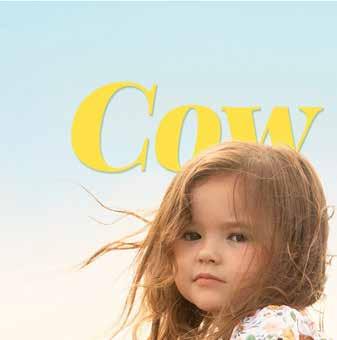



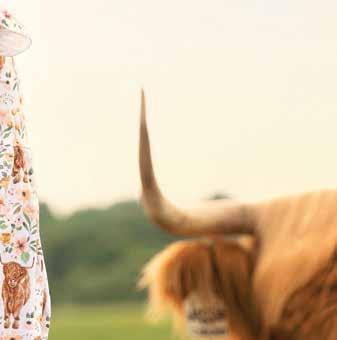

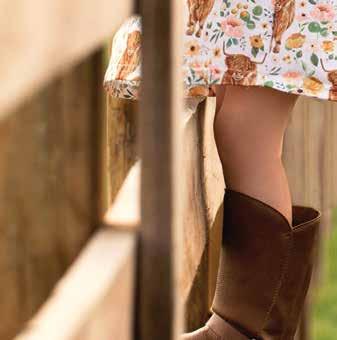
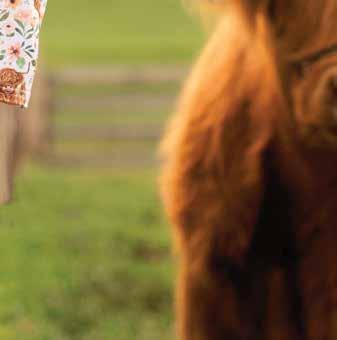

Beauties page 32
Bovine
The full sister to BJ Surpass’ dam. Offering embryos and a fall heifer pregnancy by Baldridge Limitless from this massive donor.
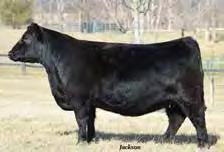
A massive daughter of RB Lady Denver 167-426. Selling sexed heifer embryos by DB Iconic and Kenny Rodgers. Her donor sister also sells!

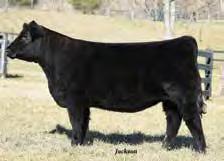
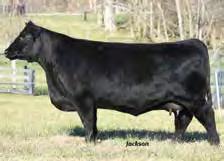


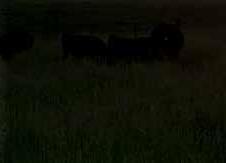

Full sib embryos to this female by Tahoe sell along with maternal sib embryos by Connealy Craftsman. Maternal at its best!

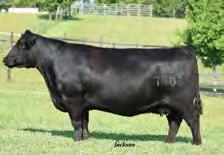


A rare daughter of Clarity due this fall to GB Fireball. Imagine that EPD script!












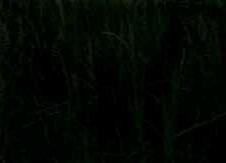
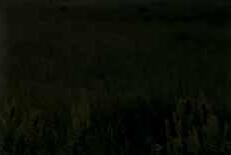

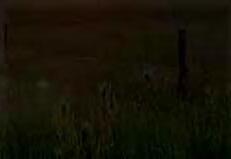
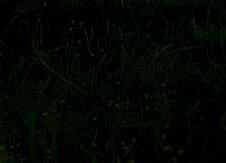
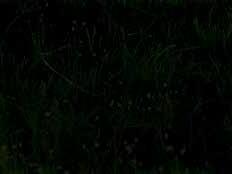










Baldridge Colonel x Boyd Rita 5149. A true power cow with an awesome BJ Surpass son at side. Safe to Sitz Resilient.












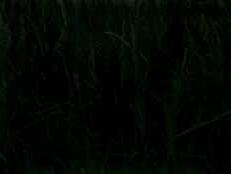

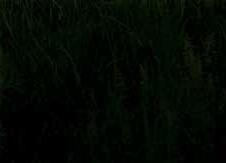


Fancy Spring Yearling and the EPDs to match. Growth Fund x Flat Top that is sure to impress!
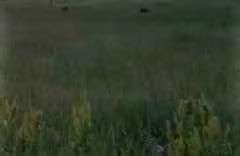
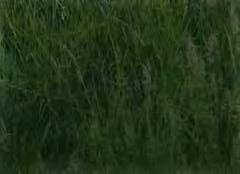
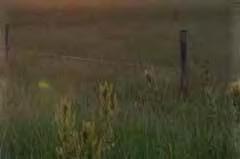

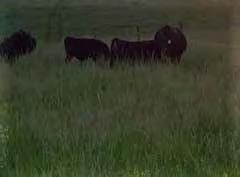
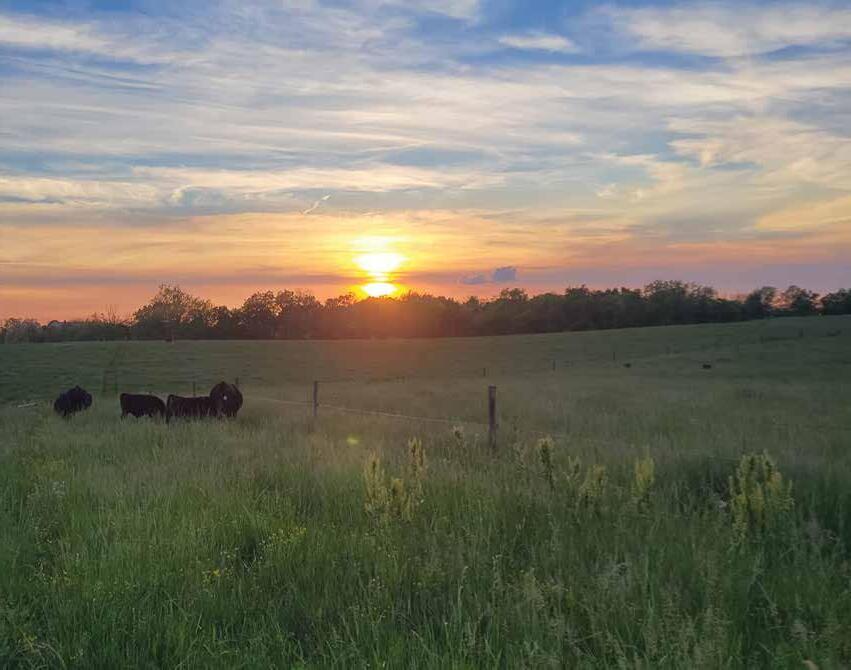
HAF Elba 218
HAF Elba 218 +*18531291 +*20180562 +*19094968 +*19273189 *19804551
C5
Ms Clarity 165-6073
Aviator’s Rita A88
Great Meadows Angus Association Jackson Marketing Solutions BJ Prophet 5261 C5 Ms Clarity 165-6073 RB Lady Tombstone 426-7503 Aviator’s Rita A88 Boyd/Myers Butter Fly M350
*20428821
CED BW WW YW Marb RE$M$B$C +9+1.2+63+118 +1.36+.94+73+182+309 25% 20%2%5%15%3%2% WW YW Doc Claw Angle Marb RE$W$C +83+148+30+.36+.49+1.15+.92+73+321 5%4%5%4%10%15%10%3% WW YW Claw Angle Marb RE$W$B$C +88+156+.35+.42+.93+.79+76+171+282 1%1%4%15%10%15%4%5%10% CED BW WW YW Doc Claw Angle $M$W +8+1.6+86+162 +28+.44+.38+78+80 3%1%10%25%10%10%4% CED BW WW YW Claw Angle $W$F +4+1.3+83+146+.35+.42+87+117 2%2%3%15%1%2% WW YW Doc Claw Angle HP$M$W$C +94+157+30+.35+.37+16.2+109+86+310 1%2% 4%4%4%4%1%2% 4% Matt Jackson Mobile 502-667-0142 Matt@jacksonmarketingsolutions.com jacksonmarketingsolutions.com Direct Sale Book Request: Great Meadows Angus Association April 22nd || 1 PM || Campbellsburg, KY 40011 Great Meadows Angus Association Jackson Marketing Solutions “Looking to the Future”

COLUMNISTS
07 Andy Bishop: President’s Thoughts
08 Ryan Quarles: Shrinking Cattle Herd in Kentucky



11 Dave Maples: Thoughts from Dave
16 Dr. Michelle Arnold: Parasite Problems Returning in Cattle Due to Dewormer Resistance?
26 Chris Teutsch: Results from 500 Hay Samples: What They Do and Do Not Tell Us, and What We Can Do About It
38 Ruminate on This: To Graze of Not to Graze?



86 Jeff Lehmkuhler: Don’t Expect Things To Return To The Way They Used To Be
FEATURE STORIES
14Commissioner Praises Passage Of Bill To Add New Division To State Vet’s Office
18Invasive Insect Species Closer To Kentucky Border
20NCBA Welcomes Introduction of Black Vulture Relief Act
30The Beef Checkoff and Lab-Grown Protein
482023 Beef Expo Sales Reach $780,000

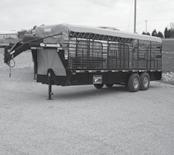
50 Pork Exports Robust in January; Slow Start for Beef Exports
52USDA Proposes New Requirements for the “Product of USA” Label Claim




52Ministers Bibeau and Ng Respond to Changes Proposed to “Product of Usa” Labelling Regulations
12County News
22NCBA Legislative Update
42Economic & Policy Update
66Membership
56Kentucky Beef Council
58Kentucky Beef Network
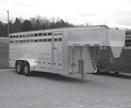
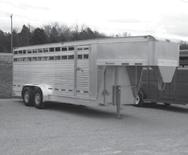


66Calendar of Events

67Advertisers Index

67Classifieds
Bovine Beauties

4 • Cow Country • April Auction Marketing Experts Nationwide! • A Deep Local Family Heritage with Wide Exposure • Long Standing Relationships in Bowling Green & Throughout the State of Kentucky • Strong History of Selling a Variety of Assets from Land to Equipment • Expertise with Assisting on 1031 Exchanges! With Corbin & Schrader on Your Team, You Get: COW COUNTRY 3/1, 4/1, 5/1, 6/1, 7/1, 8/1 1/4 Page Full Color Ad @ $556 $556 x6 = $3,336 Corbin Cowles • Ph: 270.991.2534 Email: corbin@schraderauction.com Rockfield, KY 42274 Schrader Real Estate and Auction Company, Inc. 800.451.2709 • SchraderAuction.com Russellville, Kentucky 800-766-7034 hayestrailersales.com HAYES TRAILER SALES INC Russellville, Kentucky 800-766-7034 hayestrailersales.com HAYES TRAILER SALES INC Eby Aluminum Gooseneck steel and aluminum trailers Russellville, Kentucky 800-766-7034 hayestrailersales.com HAYES TRAILER SALES INC Eby Aluminum Trailers Gooseneck steel and aluminum trailers
32 - 37
photo by Nathaniel Weaver Lincoln County
My wife runs marathons. When I say that Cassie runs marathons, I don’t mean she has run a marathon or likes to run; she legitimately is a high-level marathon runner. If you are reading this, she has a better marathon time than you. She most likely has a faster marathon time than anyone you know. Your neighbor down the street you see running every morning, the guy from your kid’s school who was a good cross-country runner, and your coworker who “likes to run marathons” all have slower times than my wife. Unless you know a professional female distance runner or a retired male collegiate runner who still logs 50+ miles a week, I can assure you she is faster than them. She is obviously extremely gifted, talented, and beautiful (yes, she reads my newsletters). However, as someone who hears her 5:00 am Sunday morning alarm every week, I know the path to get where she is could not possibly be more monotonous and boring. Her success results from her work ethic, time, and consistency. Yet, with spring break on the horizon, everyone with a house booked in Florida is trying to find a quick fix to “tone up” a little bit. They will consider any diet, workout routine, or bio hack possible to look marginally better by the end of the month. As someone that spends 300+ mornings a year in the gym to at least look like I know what a barbell is, I can guarantee that there is no such thing.
However, regarding genetic selection in beef cattle, everyone looks for a bull that can “do it all” in one generation. Marketing materials make it sound like there are bulls that can give you replacement heifers that breed at 100% conception rate, make the best cows, produce feeder calves that will top every sale, and hang carcasses that are 100% Yield Grade 1 and 2 USDA Prime. Unfortunately, that animal doesn’t exist. It is hard enough even to find an animal that is above breed average for every single trait. Whether natural service or AI, if there is a bull in the Angus breed I want to use, I am using him. I know how to do a data search and make a phone call. If an animal is unique enough, I will find a way to use him. That being said, there is not a single bull I wouldn’t change something about in a heartbeat. The changes range from more marbling, smaller mature size, better feet, greater carcass weight, higher levels of heifer fertility, better hair shed, or smaller birth weights. I am using 100% of the bulls I want to use in the entire database. Yet, there is still some deficiency in every one of them that I am trying to improve in the next generation. Using 15-20 bulls each year, we can balance out the strengths and weaknesses of each individual female through complementary breeding decisions. There are bulls I am not using that are certainly interesting but don’t quite hit the mark for
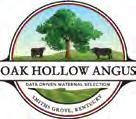
one reason or another. All this is to say no bull will fix all your problems in the first generation, but he can certainly bring you quite a few.
Judging by the questions new customers ask me about bulls, it appears that feet continue to be the biggest headache for commercial cattlemen. Whether this is due to genetics or a breeder’s bull development program (probably a little bit of both), the problem still exists. Based on the sale reports I see, I don’t think many out there are listening to their customer base, and I don’t think it is a simple fix. For example, suppose you started with a cow herd that was breed average for foot EPDs. In that case, I think it would still require two generations of breeding exclusively to bulls in the top 15% of the breed for claw and angle to achieve a cull rate of 0% on feet in a bull development program. I told this to dad, and he corrected me and said it would probably take three. The heritability of traits obviously impacts how long progress can take, but minimizing culling rates and maximizing performance on par with the breed’s top-performance genetics sounds impossible. It sounds nearly as impossible as trying to run a marathon as fast as my wife after sitting on the couch for the last year.
A lot of 8-mile runs at dawn with no one watching has given her the ability to run a fast time when everyone is watching. It is the same with cattle. I am as tired of writing as you are of reading that we need these cows to breed at 15 months old, calve at 24 months, and do so every 365 days for 12 to 15 years old. They need to stay sound and produce a calf the feedlot wants to buy with the genetic potential to grade USDA Choice and Prime. Those are the genetics the uniform calf crops come from, and that is where the money is made. Both concepts are unbelievably simplistic but very easy to try and shortcut. Without a big aerobic base for a marathon, if you try and keep up with Cassie, you will have your heart rate through the roof by 10 miles in and not finish the race. Without a fundamentally sound cow herd, you may still produce some nice calves, but you will have a lot of culls along the way. We all know what that does to profit. Whether you are training for a race or building a cow herd, the most significant progress is made by doing the boring stuff repeatedly. The idea of hard work and no shortcuts feels like something we can relate to in agriculture. Let’s not fool ourselves and think the same thing doesn’t apply to the genetics of the animals we work with as well.
Joe K. Lowe II Contact joe.lowe@icloud.com for an additional monthly newsletter

April • Cow Country • 5
BULLS, SPRING PAIRS, BRED COWS, AND BRED HEIFERS AVAILABLE SMITHS GROVE, KENTUCKY - WWW.OAKHOLLOWANGUS.COM KENNETH D. LOWE 270-202-7186 - JOE K. LOWE II 270-202-4399
EXECUTIVE COMMITTEE OFFICERS: REGIONAL DIRECTORS:
PRESIDENT
Andy Bishop
6135 High Grove Road Cox’s Creek, KY 40013 (502) 350-7609
PRESIDENT ELECT
Jeff Pettit 5745 US Highway 41 S Seebree, KY 42455 (270) 836-2963
VICE PRESIDENT
Randy Warner
2717 Ratliff Road
Sharpsburg, KY 40374 (859) 771-5280
TREASURER
Ken Adams
90 E Horseshoe Ave. Upton, KY 42784 (270) 734-1443
KCA PAST PRESIDENTS:
REGION
PAST PRESIDENT Cary King 250 Bright Leaf Drive Harrodsburg, KY 40330 (859) 613-3734
KCA PROGRAM CHAIRMAN
Daniel Hayden
6333 Herbert Road Whitesville, KY 42378 (270) 570-2815
KBC CHAIRMAN
Joe Lowe PO Box 205 Smith’s Grove, KY 42171 (270) 202-4399
KBN CHAIRMAN*
Allan Bryant
BEEF SOLUTIONS CHAIRMAN*
Jeff Pettit
Staff Accountant
Kelly Tucker
Director of Kentucky Beef Network
Becky Thompson
KBN Industry Coordinator
Dan Miller
Publication Coordinator
Carey Brown
VOLUME 36 • ISSUE 4
Membership Coordinator
Nikki Whitaker
Beef Solutions Operations Manager
Kenny Allen
KBC Director of Brand Management
Kylie Trail
KBC Director of Education
Bradon Burks
Membership and Communications Coordinator
Rachel Cain
Graphic Designer
Todd Brown
Video Production Specialist
Danny Coy
National Advertising Sales, LAN
Debby Nichols (859) 321-8770
COW COUNTRY is published monthly by THE KENTUCKY CATTLEMEN’S ASSOCIATION. The publisher reserves the right to refuse any material which he feels is unsuitable for the publication. Although the highest journalistic ethics will be maintained, the KENTUCKY CATTLEMEN’S ASSOCIATION limits its responsibilities for any errors, inaccuracies, or misprints in advertising or editorial copy. Advertisers and advertising agencies assume liability for all content of advertisements made against the publisher.

Gary Woodall...............................270-725-0819
Wayne Zoleman...........................270-315-7812
Mark Heimgartner........................270-875-2585
Jeremy Armstrong......................270-668-2056
Kenton Howard..................................................
Sara Roberson............................270-668-2428
REGION 2
Phyllis Gentry*............................502-331-1146
Thomas Bolton...................................................
Fred Thomas......................................................
Bradley Willcox............................270-862-4142
Robbie Hatfield............................270-230-6716
Chris Imbruligo...........................270-993-0543
Maggie Vaughn...........................270-590-8017
Mike Jones..................................270-670-7588
Corbin Cowles.............................270-991-2534
Glen Byrd.....................................270-991-1186
Isaac Thompson.........................270-789-8712
Kenneth Green............................270-589-7175
Andy Joe Moore..........................270-590-0841
Brian Manion...............................270-868-0253
Joe Mike Moore..........................270-670-7493
Amy Cecil....................................270-427-7207
REGION 3
Allan Bryant*...............................502-548-1379
Allen Phillips................................502-220-0948
Wanda Hawkins...........................502-321-5602
Phillip Douglas............................502-552-0688
Larry Bryant................................502-845-4615
Amanda Hall................................859-333-5001
Nicole Goecke.............................606-782-2263
Ben Tinsley.........................................................
Kevin Perkins..............................502-269-7189
Kyle Bush....................................859-588-4531
Michelle Simon...........................859-572-2600
REGION 4
Amy White*.................................859-227-2552
Brad Reynolds.............................859-200-1632
Derek Abney................................859-248-0200
Phillip Stamm.............................606-796-9175
Danielle Harmon.........................606-748-8059
Bruce Witt...................................859-585-8889
Jodi Purvis..................................606-336-3540
Mike Ravencraft..........................606-584-0310
Brandon Sears...................................................
Danny Callahan...........................859-388-0910
Jason Crowe...............................859-582-0761
REGION 5
Adam Chunglo*..........................859-613-2985
Brent Woodrum...........................859-397-1078
Tommy Spalding.........................270-402-9157
Dean Craft...................................606-634-0191
Brent Ware..................................606-305-8612
Rick Brewer.................................606-682-2352
Brent Williams.............................502-817-1511
Gary Ford....................................270-402-2194
Aaron Burke................................859-265-1172
Ryan Miller..................................502-827-5027
Phillip Reese................................606-787-1629
Jared Foley..................................270-585-1331
* Denotes member of Executive committee
6 • Cow Country • April
PASADENA DRIVE • SUITE 4 • LEXINGTON, KY 40503 • PHONE: (859) 278-0899
• INFO@KYCATTLE.ORG
176
FAX: (859) 260-2060 • WWW.KYCATTLE.ORG
1972-73 Jere Caldwell† - Boyle 2003 Mark Williams - Crittenden 1974-77 Smith T. Powell† - Lincoln 2004 Paul Napier - Lincoln 1978-79 Larry Lovell† - Union 2005 Eddie Young - Washington 1980-82 John Masters† - Mason 2006 Greg Ritter† - Barren 1983-85 Seldon Hail† - Laurel 2007 Don Pemberton - Christian 1986-87 Bob Vickery† - Wayne 2008 Billy Glenn Turpin - Madison 1988 Glenn Mackie - Bourbon 2009 Scotty Parsons - Christian 1989 Dale Lovell† - Muhlenberg 2010 Corinne Kephart - Shelby 1990 Steve Henshaw† - Union 2011 Greg Robey - Mercer 1991 Jerry Fraim - Grayson 2012 Mike Bach - Bath 1992 Glen Massengale† - Wayne 2013 Don Reynolds - Hart 1993 Dell King - Christian 2014 Steve Downs - Marion 1994 Kenneth Lowe - Warren 2015 Gary Woodall - Logan 1995 Dr. J.L.Cole - Monroe 2016 David Lemaster - Clark 1996 Harvey Mitchell - Mercer 2017 Chuck Crutcher - Hardin 1997 Jim Naive† - Spencer 2018 Bobby Foree - Henry 1998 Shelby Hughes - Logan 2019 Tim White - Fayette 1999 Hoppy Lovell - Barren 2020 Steve Dunning - Christian 2000 Charles Miller - Jessamine 2021 Chris Cooper - Madison 2001 Larry Clay - Perry 2022 Cary King - Mercer 2002 Jack Kimbrough† - Shelby †(Deceased)
Dave Maples Executive Vice President
1
Bell*.................................270-547-8547
Cook.................................270-275-1274 Ashley Holloway................................................. Leland Steely...............................270-339-3476
Bobby
Buddy
*ex officio
cover photo by Megan Tindle MDT Photography LLC, Henry County
Presidents Thoughts
Andy Bishop KCA President

It was a balmy 22 degrees when I le the house this morning and you could almost see the life draining out of the blooms on the trees that prematurely thought Spring had arrived. I must admit with the 70-degree weather I had let myself dream of an early Spring and an escape from the grasp of winter. Nonetheless, here we are and let the hay feeding continue, but the green pastures still give a glimmer of hope that we are just around the corner from turning those cows out on fresh grass. I hope everyone has taken the time to pull soil samples to see what needs attention. If you are like me you may have cut fertilizer a bit short last year with the high prices and therefore may intensify the need for getting soils ready for new growth. Fortunately, much higher cattle prices are giving us the additional dollars needed for inputs as we move forward. e near future looks bright for the cow/calf sector and I would encourage you to remember the old adage that the best cure for high prices is high prices. Be smart this year and look at using some insurance to lock in prices with minimal cost. I remember 2014 when prices were high and the crash that soon followed with most people riding the market. My advice … don’t be that producer!
I wanted to use this month’s article to correct a misconception in the industry, one that even I had several years ago. I am currently serving as Vice Chair of the Cattlemen’s Beef Board(CBB) and the rst thing people say when I tell them that is “oh that’s NCBA”. I too, thought that same thing until I got involved as the Kentucky Beef Council Chair several years ago. e Cattlemen’s Beef Board IS NOT NCBA and as a matter of fact is independent of any individual cattle organization. e Cattlemen’s Beef Board was authorized by the Beef Promotion and Research Act to administer the national checko program. e Cattlemen’s Beef Board collects 50 cents of every Checko $1. e Checko was established as part of the 1985 Farm Bill and falls under the oversight of the USDA. States keep 50 cents of that $1 under the Federation of State Beef Councils to use for local promotion while 50 cents goes to the Cattlemen’s Beef Board and is used for Domestic and International Promotion and Research. Currently there are 8 contractors to







the National Beef Checko that must meet stringent requirements to be a contractor. e Cattlemen’s Beef Board is made up of 101 members from across the U.S. that are appointed by the US Secretary of Agriculture. e Board is made up of 94 producers and 7 importers that pay into the checko . Each year contractors present Authorization Requests to producer led Checko Committees at Summer Business meeting. ose requests are analyzed, scored, and then passed on to the Beef Promotion Operating Committee who determines how funds are allocated. e Beef Promotion Operating Committee (BPOC) is made up of 10 CBB members who interview for a position and 10 Federation of State Beef Council Members (also elected producers) from across the country. e task of the BPOC is to take the Authorization Requests and determine what cuts are needed to balance the budget. is past year there were nearly $48 million dollars in requests for funding and the budget was slightly over $38 million. As you can see the BPOC has quite the task and with any business, tough decisions must be made. At the end of the day we are tasked with choosing which programs get us the biggest bang for the buck and have the largest impact. Did you know that the original $1 in 1985 is now worth $.42 cents? is coupled with a much smaller cow herd and rising costs makes the job of the BPOC even harder. Feeder calf prices in 1985 averaged $.56 cents, just imagine trying to take that and run a business today. at’s what the BPOC is dealing with!
e 8 contractors to the checko are American Farm Bureau Foundation, North American Meat Institute, US Cattlemen’s, Foundation for Meat and Poultry Research, Northeast Beef Promotion Initiative, Meat Importers Council of America, US Meat Export Federation, and National Cattlemen’s Beef Association. NCBA is the largest contractor to the Checko but IS NOT the Cattlemen’s Beef Board which o en gets misconstrued. Just for clari cation NCBA has an o ce in Denver that handles all things Checko and has a clear rewall between Denver and it’s lobbying arm which is housed in Washington DC. ere are strict rules against using checko funds for lobbying activities and its important for producers to understand that the Firewall is in place for a reason and USDA makes sure that Firewall stays in place. Being in the trenches daily with Checko items, I can honestly say that the utmost caution is given to make sure all contractors adhere to the rules of the Act and the Order and there is no gray area.

Let me close with “What does your Dollar do?” I would encourage you to go to www.bee oard.org and not only learn about the checko but see what programs are out there and meet the producers that are involved on a strictly voluntary basis. We receive zero money for our countless hours of service and do it because we are passionate about this industry and ensuring it continues for future generations. As a producer, it will be rare for you to see marketing paid for by the Checko because we already have your vote. ose monies are better spent to reach the millions of consumers outside of agriculture in places like social media, Spotify, Tiktok, Pandora, and much more. Unless you hang out in those places you aren’t likely to see the messaging, so I encourage you to take the time to visit our website and see “What



your Dollar does!”



April • Cow Country • 7
Kentucky Cattlemen’s Association President 502-350-7609
scan to visit BEEFBOARD.ORG
Shrinking Cattle Herd in Kentucky
Ryan Quarles Commissioner of Agriculture

Fi y-six years ago, Lyndon Johnson was president, the best-selling album was e Beatles’ “Sgt. Pepper’s Lonely Hearts Club Band,” and a gallon of gas cost 33 cents. 1967 was also the last time the number of beef cows in Kentucky was as low as it is now. Kentucky’s beef cow inventory was estimated at 895,000 head on Jan. 1, 2023, according to the Kentucky Field O ce of the U.S. Department of Agriculture’s National Agricultural Statistics Service (NASS).
e drop in numbers follows a national trend as NASS estimates a 3.5-percent reduction nationally in beef cattle inventory to 28.9 million head. at’s the lowest total in 61 years – since John F. Kennedy was president, the “West Side Story” soundtrack was the best-selling album, and gas cost 31 cents, all in 1962.
Across the nation, all cattle and calves as of Jan. 1 totaled 89.3 million head, 3 percent below the 92.1 million head just a year prior, according to NASS. All cows and heifers that have calved, at 38.3 million head, were 3 percent below the 39.4 million head at the
start of 2022. e 2022 calf crop was estimated at 34.5 million head, down 2 percent from the previous year.

e Kentucky cattle and calf inventory on Jan. 1 was estimated at 1.93 million head, 100,000 fewer than last year, according to NASS. Cows and heifers that have calved were estimated at 940,000 head, down 70,000. e 2022 calf crop was estimated at 920,000 head, down 60,000. Despite the drop in numbers, cattle are still an important livestock to Kentucky. e commonwealth ranks 14th nationally for cattle inventory and remains the state with the largest number of beef cattle east of the Mississippi River.
Kenny Burdine, agricultural economist for the University of Kentucky College of Agriculture, Food and Environment, has been following the situation closely. He attributed the drop in our cattle numbers to “a combination of dry weather, high input costs, and strong cull-cow prices.”
Kentucky producers also dealt with extreme weather events such as tornadoes in western Kentucky in late 2021 and ooding in eastern
Kentucky last summer. Burdine called the weather “a perfect storm” with more than half of the state mired in a moderate drought last fall and far western Kentucky baking in a severe drought.
Dry conditions forced cattle producers to start feeding hay a lot earlier than usual, leading to tighter hay supplies and higher winterfeeding costs for cow-calf producers. Winter feed is the largest expense for most cow-calf operations, and most years, producers can buy hay for $60-$80 per ton, according to Burdine. But he added that recent hay auctions in Kentucky have seen the same quality hay selling for $100 per ton or more.

Burdine said those higher costs result in a signi cant increase in daily feeding costs, causing some producers to reduce their numbers. Cattle markets have been mixed but have been trending stronger, which he expects will continue into the spring for calf and feeder markets.
e silver lining in a lower cattle inventory is it may result in higher sale prices for Kentucky cattle producers.

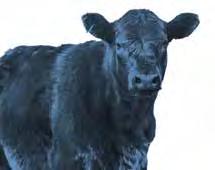
8 • Cow Country • April
Livemusic|freelunch|tradeshow|Vendorsmarket| facilitytours|livedemos|Prizes 888-618-6455|cpcfeeds.com|@cpcfeeds 98celsorrd|fountainrun,ky f 88 CustomerAppreciation+TradeShow+VendorsMarket SavetheDate! Thursday 9:00am SEPTEMBER7th
STONE GATE FARMS OPTIMUM TRAIT GENETICS

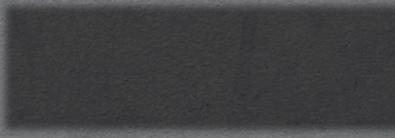










A special thank you to all the buyers, bidders and participants at our annual production sale. We were blessed to have so many repeat buyers and old friends pay us a visit. Exciting times are ahead for the cattle industry and we are enthusiastic about the future, with several young buyers deciding to start their herds with Stone Gate cattle. We understand the investment it takes to build and maintain a cowherd, that’s why we have been so diligent over the years to provide our customers with consistent and predictable cattle.

April • Cow Country • 9 ALL AGES WELCOME SCHEDULE A GROUP VISIT CHOOSE YOUR LESSON PLAN CATERING IS AVAILABLE VISIT US TODAY! THE YARDS is an education center focusing on the science and practices of the beef industry. Educational opportunities provide a unique learning experience based on its location in the Blue Grass Regional Stockyards Marketplace. This environment fosters complex thinking, experiential learning, and life skill application. BBURKS@KYCATTLE.ORG (859) 382-4303
1669 Mill Creek Rd. • Flemingsburg, KY 41041 Charles Cannon: 606-849-4278 • Cell: 606-748-0747 Chris Cannon: 606-748-0407 • Victoria Cannon: 606-748-5420 www.stonegatefarms.com • stonegateangus@gmail.com
PRIVATE TREATY SALES
A GOOD SELECTION OF YEARLING BULLS AVAILABLE FIRST CALF COMMERCIAL HEIFERS WITH CALVES AT SIDE


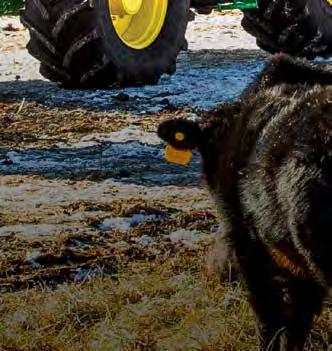
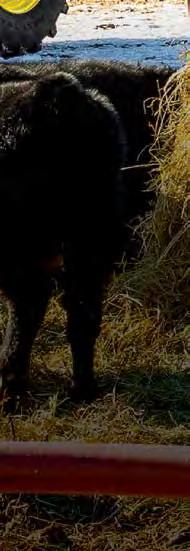
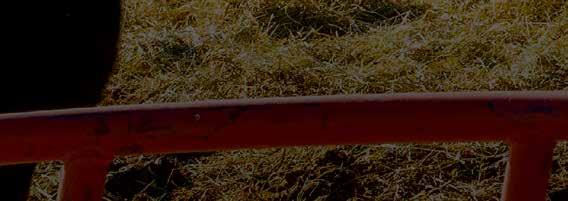

Visit JohnDeere.com/6R or contact your John Deere dealer to learn more. John Deere 6R
the power, reliability and efficiency you need with John Deere 6R Utility Tractors. Improve productivity with the power-to-weight ratio and an extra power boost when you need it. Improve engine cooling by blowing out chaff in the hay field with the reversible fan. Mixing feed, weighing bales and loading goods have never been easier, thanks to loader technologies on the 6Rs. Ride in style in the top-of-the-line, comfortable cab with better visibility, ergonomic controls and a smooth ride in the John Deere 6R.
Premium Performance Get
Thoughts From Dave
Dave Maples Executive Vice President

Our o ce has spent a great deal of time this month on the issues of veterinarians and the Veterinary Medicine Practice Act. If you are interested you can read House Bill 167 which is an ACT relating to veterinarian licensing. Just to give you a heads up, it is a 68 page bill that is very comprehensive. It includes nearly all aspects of veterinary medicine including small animals, food animals and telemedicine.
ere are two di erent bills relating to the veterinary profession working through the legislature this session along with a task force to come up with recommendations or ideas to address the shortage of rural veterinarians. e search for the State Veterinarian is going on at the same time.
And don’t forget that the reality of over-thecounter antibiotics will end come June 2023. Cattlemen will have to have a prescription to purchase the common antibiotics that we have all used for years that you purchased at the local farm supply store. A VCPR (Veterinary Client Patient Relationship) will be highly
important going forward. is will require a veterinarian to visit your farm at least once every 12 months. You need to establish a VCPR anyway and work with your local veterinarian.
I don’t think most people realize the importance of the State Veterinarian position. Today we have no State Veterinarian or Assistant State Veterinarian. is is not a good position to be in with all the livestock and equine that Kentucky is home to. Over the years we have been very fortunate to have a long run with Dr. Bob Stout and Dr. Don Notter before him. Dr. Katie Flynn was just getting into the job but a better o er came along and she couldn’t turn it down. It looks like the compensation package is going to have to be better if we are going to attract the high-quality personnel that is required to manage the State Veterinarian o ce. A veterinarian can just about name their price in today’s market. For some reason I have managed to get on the telehealth email

list where I get correspondence from several of the televet companies. One of the companies was o ering paid time o at a top-rated vacation property courtesy of their company if you came to work for them.
e one thing I have had to come to grips with on this issue is that the veterinary industry is going to change and the way you as a cattleman interact with your veterinarian could be di erent than the way we grew up with our local veterinarian. e veterinary industry is consolidating just like about everything else.
As for the shortages of rural veterinarians it is going to be important that we as cattlemen identify young people in high school that have a strong desire to be a veterinarian and then come back to our rural communities to practice. I had a good conversation with the folks at Auburn about a mentorship program with these select students. e details of the program have not been worked out but it sure sounded like a good idea that KCA could support.
April • Cow Country • 11
BRACKEN COUNTY NEWS
Submitted by Meg Strausbaugh
Bracken County Cattlemen enjoyed a great meeting on February 23rd! A delicious roast beef meal from K's IGA was served by Bracken County FFA students and sponsored by Dr. Darrin Stan eld and presentation from Brent Tolle with Boehringer Ingleheim. Members so generously donated $393 for our scholarship funds. And a collection was also taken up in support of our local animal shelter, in which a check of $189 was presented to Robbin Snapp, Animal shelter director.

We had some generous donations for prizes! Two $50 Brooksville Farm Supply gi certi cates donated by Brooksville Farm supply, a case of oil donated by Kubota of the TriState, Augusta store, and a $25 Brooksville Farm Supply gi certi cate donated by David and MaryAnn Cummins. Winners: Crystal Dunn, Michael McClanahan, Debbie Hargett, Tina Teegarden.
We are currently 170 members strong! It's not too late to join! If you would like to be part of the board of directors in the upcoming membership year, see President Nicole Goecke.
KCA HALL OF FAME AWARD
12 • Cow Country • April
Judge Executive Tina Teegarden, Bracken County Animal Shelter Director Robbin Snapp, and Bracken County Cattlemen's Association President Nicole Goecke
The Kentucky Cattlemen’s Association Hall of Fame is designed to honor a member of the organization that has given time, service, and talent to the betterment of the Cattlemen’s Association at the county and/or state levels. 2024 applications must be postmarked by June 30th, 2023. Call us at (859) 278-0899 with questions. Application available at kycattle.org. DO YOU KNOW AN OUTSTANDING CATTLEMAN?
FRANKLIN COUNTY NEWS

Submitted by Crystal
Harrod
e Franklin County Cattlemen's Association held an educational meeting on March 9th at the Franklin County Extension O ce. e meal was sponsored with le over funds from a previous sponsorship from Shelby Vet Clinic and Blue Grass Stockyards. We had 50 members in attendance.

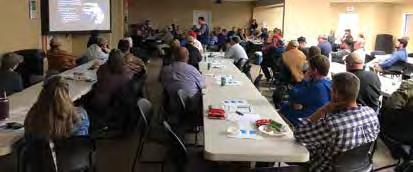



Jimmy Chambers, Versailles USDA Farm Service Agency Executive Director, explained in detail how additional emergency relief and pandemic assistance was available from the USDA through the ERP Phase Two as well as the new PARP program. He also reminded producers about LIP and the need to keep accurate records and document losses. He also advised that anyone who had experienced recent wind damage to keep records and take pictures, before if possible, but also immediately a er any clean up or debris removal in case there is assistance in the future.
LINCOLN COUNTY NEWS
Submitted by Tyler Miller
Jack Blair presents a pair of bid overalls to Lincoln County’s Past President, Buddy Pence, for his service and leadership to the county Cattlemen’s Association. Buddy did a wonderful job during his time as President. e overalls will be embroidered with the LCCA logo.

e annual Lincoln County Cattleman’s Cow Calf and Farm Bureau chemical meeting went o with a bang. A delicious steak dinner was prepared and served to a room full of attendees. Our KBN facilitator, Jacob Settles, did a wonderful job addressing the group. We are lucky to have the KBN facilitators that we have in this state!
Dr. Carlton, a local vet came and spoke on the topic of delivering backwards and upside down calves. Dr. Carlton did a knock out job and was very thorough in his presentation. Next up was Dr. Les Anderson. If you have ever heard a presentation from Les, then you realize the treat we had that evening. Dr. Anderson did a fabulous job speaking about the importance of controlling your breeding season. Dr. Anderson gave examples of controlling the breeding season vs not and spoke on di erent products and how to use those products to shorten the breeding season.
e last speaker for the night was Mr. Je Morris, a cattleman and a director on the Farm Bureau board of directors. Je spoke on the chemical program explaining the bene ts of purchasing your farm chemical through this program.
Keenan Bishop, Franklin County Ag and Natural Resources Agent, presented an introductory how-to on the X10D app for managing your beef cattle herd and keeping up to date with local events and educational opportunities. e X10D app could be a valuable tool for producers to use as documentation for USDA programs such as LIP.
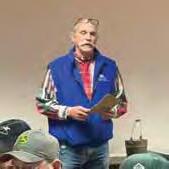
April • Cow Country • 13
Each mL contains 300 mg of oxytetracycline base (equivalent to 323.5 mg of oxytetracycline dihydrate).
For Use in Beef Cattle, Non-lactating Dairy Cattle, Calves, Including pre-ruminating (veal) calves
BRIEF SUMMARY (For full Prescribing Information, see package insert.)
INDICATIONS: NOROMYCIN 300 LA is intended for use in treatment for the following diseases when due to oxytetracycline-susceptible organisms:
Beef cattle, non-lactating dairy cattle, calves, including pre-ruminating (veal) calves: NOROMYCIN 300 LA is indicated in the treatment of pneumonia and shipping fever complex associated with Pasteurella spp., and Histophilus spp. NOROMYCIN 300 LA is indicated for the treatment of infectious bovine keratoconjunctivitis (pink eye) caused by Moraxella bovis, foot-rot and diphtheria caused by Fusobacterium necrophorum; bacterial enteritis (scours) caused by Escherichia coli; wooden tongue caused by Actinobacillus lignieresii; leptospirosis caused by Leptospira pomona; and wound infections and acute metritis caused by strains of staphylococcal and streptococcal organisms sensitive to oxytetracycline.
Swine: NOROMYCIN 300 LA is indicated in the treatment of bacterial enteritis (scours, colibacillosis) caused by Escherichia coli; pneumonia caused by Pasteurella multocida; and leptospirosis caused by Leptospira pomona.
In sows NOROMYCIN 300 LA is indicated as an aid in control of infectious enteritis (baby pig scours, colibacillosis) in suckling pigs caused by Escherichia coli.
PRECAUTIONS:
Exceeding the highest recommended level of drug per pound of bodyweight per day, administering more than the recommended number of treatments, and/or exceeding 10 mL intramuscularly or subcutaneously per injection site in adult beef cattle and non-lactating dairy cattle and 5 mL intramuscularly per injection site in adult swine, may result in antibiotic residues beyond the withdrawal time.
Consult with your veterinarian prior to administering this product in order to determine the proper treatment required in the event of an adverse reaction. At the first sign of any adverse reaction, discontinue use of the product and seek the advice of your veterinarian. Some of the reactions may be attributable either to anaphylaxis (an allergic reaction) or to cardiovascular collapse of unknown cause.
Shortly after injection treated animals may have transient hemoglobinuria resulting in darkened urine.
As with all antibiotic preparations, use of this drug may result in overgrowth of non-susceptible organisms, including fungi. The absence of a favorable response following treatment, or the development of new signs or symptoms may suggest an overgrowth of non-susceptible organisms. If superinfections occur, the use of this product should be discontinued and appropriate specific therapy should be instituted.
Since bacteriostatic drugs may interfere with the bactericidal action of penicillin, it is advisable to avoid giving NOROMYCIN 300 LA in conjunction with penicillin.
WARNINGS:
Warnings: Discontinue treatment at least 28 days prior to slaughter of cattle and swine. Not for use in lactating dairy animals. Rapid intravenous administration may result in animal collapse. Oxytetracycline should be administered intravenously slowly over a period of at least 5 minutes.

CAUTION: Intramuscular or subcutaneous injection may result in local tissue reactions which persists beyond the slaughter withdrawal period. This may result in trim loss of edible tissue at slaughter.
Intramuscular injection in the rump area may cause mild temporary lameness associated with swelling at the injection site. Subcutaneous injection in the neck area may cause swelling at the injection site.
ADVERSE REACTIONS:
Reports of adverse reactions associated with oxytetracycline administration include injection site swelling, restlessness, ataxia, trembling, swelling of eyelids, ears, muzzle, anus and vulva (or scrotum and sheath in males), respiratory abnormalities (labored breathing), frothing at the mouth, collapse and possibly death. Some of these reactions may be attributed either to anaphylaxis (an allergic reaction) or to cardiovascular collapse of unknown cause.
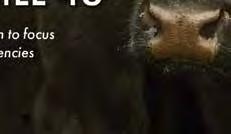
To report a suspected adverse reaction call 1-866-591-5777. Livestock
Commissioner Praises Passage Of Bill To Add
New Division To State Vet’s Offi ce
DIVISION WOULD FOCUS ON EMERGENCY PREPAREDNESS, RESPONSE
FRANKFORT (March 15, 2023) – Kentucky
Commissioner of Agriculture Dr. Ryan Quarles is applauding the work of Kentucky legislators a er they passed a bill to add a new division within the Kentucky Department of Agriculture’s (KDA) O ce of the State Veterinarian (OSV).

Senate Bill 46 (SB46) enhances the department’s preparedness and response to animal emergencies.

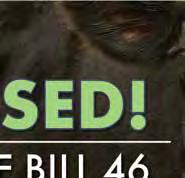
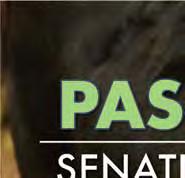
Sen. Jason Howell (R-Murray), who is the chairman of the Senate Agriculture Committee, sponsored the bill.
“I appreciate Sen. Howell’s leadership and the legislators in the Kentucky House and Senate recognizing the importance of OSV,” Commissioner Quarles said. “OSV’s top priority is protecting the health of livestock and poultry in the commonwealth. e passage of this bill will allow KDA to start changes to help us enhance this ability, especially in the case of an animal health emergency.”
“I was proud to work with Commissioner Quarles on this bill to increase sta ng and emergency preparedness for the O ce of the State Veterinarian,” Sen. Howell said. “ is bill restructures the State Vet’s o ce and readies it for the necessary improvements needed to increase its capacity to respond to animal health emergencies, which is a bene t to all Kentucky residents.”
e need forSB46 was rst introduced in November when Commissioner Quarles, KDA Chief of Sta Keith Rogers, and former State Veterinarian Dr. Katie Flynn testi ed before the Interim Joint Committee on Agriculture. e bill passed out of the Senate and House this month with overwhelming support. e bill now goes to the governor for signing.
In addition to creating the Division of Emergency Preparedness and Response to the State Vet o ce, SB46 renames two current divisions including the Division of Animal Health to the Division of Regulatory Field Services and the Division of Producer Services to the Division of Animal Health Programs. e changes address the top three de ciencies the O ce of the State Veterinarian (OSV) identi ed during the last year: emergency programs, policy and regulations, and outreach and education.
OSV is currently made up of 35 positions, led by the state veterinarian and deputy state vet. Most of the jobs, 25, are in Animal Health. e remaining 10 sta are in the Producer Services division. SB46 would provide for increased sta , allowing OSV to be better positioned for its principal role in protecting Kentucky’s animal agriculture. OSV’s need for more sta has been put on critical display in the last 18 months as the o ce dealt with several animal disease and natural disaster occurrences, including a Chronic Wasting Disease case in a deer near the Tennessee border, which initiated required surveillance throughout several counties in Kentucky; devastating tornadoes that impacted agriculture across Western Kentucky; several outbreaks of Highly Pathogenic Avian In uenza, a deadly virus for domesticated poultry; and widespread ooding in Eastern Kentucky. SB46 would allow the state vet’s o ce to be in a better position to defend the state’s agriculture livestock against disease and nature disasters, while at the same time completing the other tasks that maintain the health of the state’s herds and ocks.
14 • Cow Country • April
Drug - Not for Human Use. Restricted Drug(s) California. Use Only as Directed.
by: Norbrook, Inc. Lenexa, KS 66219 MADE IN THE UK Rev: August 2021 Version: I08 (oxytetracycline injection) ANTIBIOTIC Noromycin® 300 LA Approved by FDA under NADA # 141-143
Manufactured
33% ]




MORE HEAD TREATED PER BOTTLE*

It pays to compare labels when treating seasonal diseases in catt le.
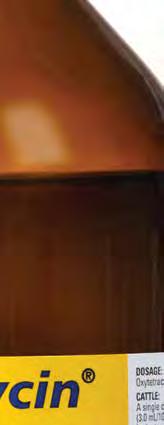
Noromycin® 300 LA (oxytetracycline 300 mg/mL) is your effective, broad-spectrum and economical




With its 33% lower volume dose per injection, *compared to 200 mg/mL oxytetracycline injectables, Noromycin® 300 LA (oxytetracycline 300 mg/mL) is your effective, broad-spectrum and economical antibiotic for seasonal diseases in beef cattle, non-lactating dairy cattle and swine. Stop by your local animal health provider or visit norbrook.com.
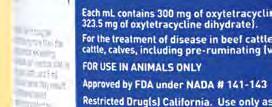
PREPARE FOR THE PRESCRIPTION-ONLY STATUS COMING SOON. SET A PLAN IN PLACE NOW TO ENSURE CONTINUED ACCESS TO NOROMYCIN® 300 LA.
Observe label directions and withdrawal times. Not for use in lactating dairy animals. Adverse reactions, including injection site swelling, restlessness, ataxia, trembling, respiratory abnormalities (labored breathing), collapse and possibly death have been reported. See product labeling for full product information.
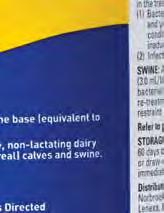
April • Cow Country • 15
1222-143-I08A
© 2023 Norbrook Laboratories Limited. All rights reserved. The Norbrook logos and Noromycin are registered trademarks of Norbrook Laboratories Limited.
Parasite Problems Returning in Cattle Due to Dewormer Resistance ?
Dr. Michelle Arnold UK Veterinary Diagnostic Laboratory

UK EXTENSION TEAMS UP WITH KBN AND MERCK ANIMAL HEALTH TO ASSESS PARASITE BURDENS IN KY BEEF COW/CALF OPERATIONS
Dewormers (anthelmintics), when given correctly, are not killing intestinal parasites of cattle as they used to. Although new drug “classes” entered the market from the 1950s to the 1980s, it has now been over 40 years since ivermectin was introduced in 1981. Basically ‘we have what we have’ which is 3 major chemical classes or families of dewormers known as the Benzimidazoles (SafeGuard® & Panacur®/ Valbazen®/Synanthic®), the Macrocyclic Lactones or MLs (Ivomec®/ Cydectin®/ Eprinex® & LongRange®/Dectomax®/ generic ivermectins) and the Imidazothiazoles/ Tetrahydropyrimidines (Rumatel®/ Strongid®/ Prohibit® or Levasol®). ese dewormers are gradually losing e ectiveness against livestock parasites with no new products on the horizon to take their place.
“Anthelmintic resistance” is the term used for the ability of a parasite to survive treatment with a chemical dewormer due to a genetic change (mutation) that would otherwise be lethal. Only the parasites that survive a er deworming will go on to reproduce and may pass a copy of their newly formed “resistance gene” to their o spring. But this is only half of the story. If one remembers back to genetics, one gene comes from a female and one from a male to produce o spring with 2 copies of a gene. For fully resistant parasites to develop, both parents must pass a copy of this “bad” gene to the o spring. ese resistant genes build up slowly but steadily in the parasite population, especially from repeated use of dewormers over many years, and they do not revert back to susceptibility. Resistant worms are not more aggressive or deadly; they simply survive in higher numbers a er deworming, resulting in production loss and disease in the most susceptible animals.
Consequences of parasites are mostly seen in younger animals, especially weaned calves and replacement heifers, since adult cattle develop an immunity to the e ects of parasites. Most infections in cattle are a combination of several di erent worm species but, in general, gastrointestinal parasites cause anorexia and reduce the animal’s ability to e ciently convert forage to milk and muscle. e number one sign of a parasite problem is lower than expected production, including less than genetic potential rate of gain, feed conversion, growth, and reproduction. is is potentially costing producers due to reduced weaning weights, delayed puberty, decreased fertility and pregnancy rates, reduced feed e ciency and
immune suppression in young cattle, especially in cattle ages 2 and younger. As exposure to parasites increases with age, the immune system reduces worm infections and suppresses worm egg production. is immunity to parasites is a moderately heritable trait (0.3). Unfortunately, the dependence on chemical dewormers has allowed selection of bulls and replacement females with high production numbers but has ignored any potential genetic contribution to ghting parasites. Additionally, chemical deworming has allowed continued husbandry and pasture management factors that keep worm burdens high. As an example, overstocking a pasture results in more feces, more worm eggs and larvae a er egg hatching, shorter grass and more parasites in animals forced to graze near manure piles. Young, growing animals are at highest risk due to lack of previous exposure to parasites and a naïve immune system. How is it possible to know if dewormer resistance is a problem in a herd? e best way to test is a Fecal Egg Count Reduction Test (FECRT) based on the knowledge that dead worms don’t lay eggs. is test basically involves taking fecal samples from 20 random animals within a production group (cows, calves, or replacement heifers) at the time of deworming and sending them to a laboratory for a fecal egg count (FEC). Fecal samples are collected again from the same production group 14 days later and those samples are sent to the same laboratory for a second FEC. e second samples do not have to be collected from the same individual animals but do need to be from the same group collected previously. If the dewormer worked e ectively, there should be at least a 90% reduction in the average or mean number of eggs from the rst sample to the second sample. “Resistance” is present when the correct delivery of the correct dose of the dewormer to a healthy animal fails to produce at least a 90% reduction in the number of parasite eggs. It is important to understand that a decrease in “anthelmintic e ectiveness” or “treatment failure” may be for reasons other than genetic or heritable resistance in the parasite population. Many factors can cause smaller than expected reductions in fecal egg count numbers including underdosing dewormers from errors in weight estimation, dosing equipment not calibrated correctly and/or not working properly, applying pour-ons to the hair of an animal rather than skin, use of expired products, and errors in sample collection and shipment, just to name a few.
How can we slow the development of resistance to dewormers? First and foremost, we must understand the parasite prevalence (the proportion of cattle with a large parasite load in a given time period) in KY cattle in order to properly direct research and extension interventions to lessen the e ect of parasites on health and production. Secondly, we have to examine the current level of resistance to dewormers through FECRTs performed throughout the Commonwealth. Finally, it is important to identify the predominant types of gastrointestinal parasites in our cattle in order to correctly interpret the FEC. Most of the major parasites in cattle are classi ed as “strongyles” and their eggs are basically indistinguishable. However, a PCR is now available to identify the parasite genus and species as there are concerns that climate change, intensive livestock management and dewormer resistance issues have fundamentally changed our picture of “expected” parasite burdens in production classes of cattle. To accomplish these three tasks, UK Extension faculty and agents, in conjunction with KBN and Merck Animal Health, have launched a parasite study that is set to begin in the Spring of 2023 in beef cow/calf operations in KY and we need your herds.
To participate, collaborating herds must be planning to administer a dewormer in BOTH the spring and fall of the year. Producers may use any dewormer they normally use or one recommended by their veterinarian. It is important to understand that dewormer will NOT be provided to participating herds! Fecal samples will be collected twice in the spring and twice in the fall from the same group of animals. Producers will be asked to complete a short questionnaire requesting basic information on the herd. Once all the data is compiled, the information will be shared with the producer and his/her veterinarian, if desired. If you wish to be considered for enrollment in this important study, please contact your local County Extension agent and convey your interest in joining.
Reducing unnecessary treatment with dewormers, making sure the dewormers used are e ective, and making sure deworming is performed correctly all contribute to fewer resistant genes in parasites. In addition, environmental management (see box) will help create safer pastures and lessen the need for chemical dewormers.
16 • Cow Country • April
Environmental management to reduce exposure of the host animal is central to parasite control. The following list of practices will help create safer pastures with lower worm numbers and result in less need for anthelmintic (dewormer) treatment:


Stocking rate is exceptionally important, as overgrazing forces consumption of forage close to the soil surface where the larvae are concentrated. Most larvae never migrate higher than 4-6 inches on forage.







Flipping pastures, tilling and reseeding, or removing a cutting of hay will decrease existing worm burdens.
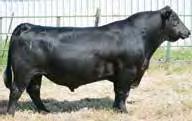
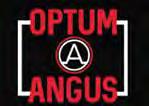


Exposure to ultraviolet light (sunshine) kills larvae, so removal of extensive overgrowth of pasture or heavy thatch is recommended.







Pasture rotation provides nutritious forage for growth and development but is usually not rested an adequate length of time to decrease the level of worm contamination. Allowing calves to creep graze in clean pastures ahead of adults in a rotational grazing situation will minimize the exposure of the most susceptible animals.


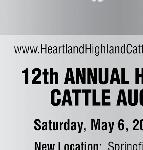
Areas of highest risk are those where animals congregate, such as watering troughs, shady areas, or sheltered areas, because manure buildup and high moisture are conducive to larvae survival.










Grazing after the dew dries in the morning decreases consumption of larvae from pasture, since moisture is necessary for larval movement up a blade of grass.


If practical, cattle and small ruminants can be grazed together or alternately, where each consumes the parasites of the other. This reduces available infective larvae for the preferred host species.



























April • Cow Country • 17
ANNUAL FEMALE SALE OF THE GAR Home Town Selling Limited Number of Herd Bull Prospects Sired By: Salvation, Greater Good, Identified, Veracious, Conclusion, and Hometown First time, locally offered prospects! SATURDAY • APRIL 22 • SEAMAN, OHIO New Date! 15898 State Route 247 • Seaman, OH 45679 • 937-205-2996 • optumangus@gmail.com Owners: Wes & Claudia Mitchell • Tim & Patty Sandker • Andrew & Courtney Mitchell Herdsman: Ben Wheeler 606-301-1961 • Office Manager: Courtney Mitchell Sale Managed by: Cotton & Associates • www.cotton-associates.com www.optumangus.com & Mill Brae Identified 3/9/23 2:53 PM
Invasive Insect Species Closer To Kentucky Border

 Jordan Strickler Agricultural Communications Specialist
Jordan Strickler Agricultural Communications Specialist
LEXINGTON, Ky., (March 8, 2023) -- Kentucky residents should be on the lookout for an invasive bug with the potential to disrupt multiple industries. People have observed the spotted lantern y close to the Kentucky border in Ohio and Indiana. If the insect enters the commonwealth, it can impact wine, apples, Christmas trees, hops and Kentucky’s sizable forest industries.
“Spotted lantern ies feed on over 70 di erent host plants and could really wreck a number of small commodities we have in the state,” said Jonathan Larson, entomology assistant professor. “ ey also feed on hardwood trees, so once they get in people's yards, their numbers can just explode. It kind of becomes a quality-of-life issue. Some people in Pennsylvania, where the lantern ies were rst discovered in 2014, don’t even want to go outside anymore. ere's so many of these bugs jumping and ying around on their property.”
While feeding, the spotted lantern y excretes a sugary substance called honeydew. When large lantern y populations establish themselves, the insects create so much honeydew that black sooty mold thrives, negatively impacting other vegetation. is honeydew also attracts stinging insects, who feed on the sugary material. Even though the impacts of infestation in diverse woodlands and natural areas are not as straightforward as in more uniform agricultural and landscape settings, the extra strain the bug puts on trees' resources may worsen tree stress.
“ e spotted lantern y can really devastate plant health, so if someone sees something they suspect is a lantern y they either need to catch it or take a picture,” Larson said. “Other insects in the state can resemble the spotted lantern y, so we must verify the insect rst.”
Stripes and spots adorn an adult’s front wings, while the back wings are a brilliant red, contrasting with the rest of the body's white, black and khaki coloring. If spotted lantern ies appear in Kentucky and stay relatively contained, Larson said professionals may be able to locally eradicate the insects to prevent their spread and establishment. Treating potential host trees with insecticides and eradicating Tree-of-Heaven and other preferred hosts will help with containment. Early detection increases the chances of controlling the insect’s spread.
e invasive Tree-of-Heaven is one of the insects’ favorite hosts. e fast-growing tree thrives in both urban and woodland settings, outcompeting native species and tolerating a wide range of environmental conditions. It commonly a ects disturbed urban areas, roadsides and railroad tracks, also invading natural areas, particularly a er harvests in wooded areas, where its papery wind-borne seeds can quickly colonize and form dense stands.
“If the spotted lantern y makes it into Kentucky, it could lead to restrictions on the movement of goods such as lumber, the need for quarantines and even the requirement of permits to travel or move goods out of infested areas,” Larson said. “All of this could have economic or quality-of-life repercussions for Kentuckians living in infested areas.”
To learn more about spotted lantern ies, visit https://entomology.ca.uky. edu/ef465. Kentuckians who think they spot a spotted lantern y, please send pictures to the UK Department of Entomology at reportapest@uky. edu.
Selling 225 Fall Calving Bred Heifers
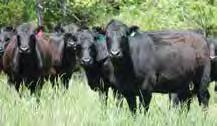
Saturday, May 20, 2023 12:00 Noon Central Time
Kentucky - Tennessee Livestock Market
Guthrie, Kentucky
All heifers qualify for both Kentucky and Tennessee Cost Share Programs
See these heifers at: www.kyheifersale.com
For more information contact:
Kevin Laurent, University of Kentucky (270) 625-0994
Mark Barnett, KY-TN Livestock Market (931) 624-7176
Tom Barnett, KY-TN Livestock Market (931) 624-7376
18 • Cow Country • April
We s t Ke n t u ck y S e l e c t B r e d H e i f e r S a l e
Spotted lanternflies are unique looking insects, with distinctly colored wings and unique patterns. The front wings are khaki pink with black spots and broken black lines. The back wings are a mixture of red, white, and black.
Sponsored by the Univ. of Kentucky and Univ. of Tennessee Cooperative Extension Service
All
heifers are guaranteed bred to bulls with known EPDs and have met stringent requirements for health, quality and pelvic measurements.































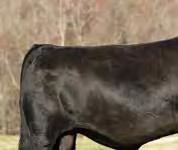








ANGUS BULL & FEMALE SALE Pasture Performance-Tested Please call or email us today to be added to our mailing list. PO Box 570, Aldie, Virginia 20105 | (703) 327-4863 Office • (703) 327-4777 FAX • (703) 930-1841 Mark’s Cell Www.whitestonefarm.com | office@whitestonefarm.com 40 Females Whitestone Evergreen 5029 $B$C +14-.3+60+116+23+1.38+1.29+64+56+204+329 Aldie, VA ANNUAL $B$C +55+175+251 Visit us on Facebook! S S Enforcer E812 | Dam: Musgrave 316 Stunner | Dam: B&B Erica 605
NCBA Welcomes Introduction of Black Vulture Relief Act
WASHINGTON (March 9, 2022) – Today, the National Cattlemen’s Beef Association (NCBA) welcomed the introduction of the bipartisan Black Vulture Relief Act, led by Rep. John Rose (R-TN) and Rep. Darren Soto (D-FL).
“Across the country, cattle producers are coping with extreme input costs and the worst in ation rate in 40 years. Livestock deaths due to black vultures are a nancial loss that no one can a ord right now,” said NCBA Director of Government A airs Sigrid Johannes. “Giving producers greater exibility on black vulture management means one less nancial burden to worry about.
We appreciate Congressman Rose and Congressman Soto’s leadership and commonsense approach to controlling this abundant predator species.”
e bill would allow a cattle producer to “take” (capture, kill, disperse, or transport) black vultures that pose a risk to livestock. Additionally, the bill reduces permitting burdens and red tape by instituting a simple report that producers submit once per year detailing the number of black vultures they took. Streamlining the system and li ing the cap on number of black vultures that producers can take is a commonsense approach to managing a fully recovered, aggressive, predator species.
“Black vultures have developed into a lethal predator for newborn calves, costing Tennessee cattle producers thousands of dollars in lost revenue each year. We appreciate Congressman Rose’s bill as a signi cant tool to help control the over-population of these predators,” said Tennessee Cattlemen’s Association Executive Director Charles Hord.
Black vulture depredation rates have increased across the Southeast in recent years, surpassing 30 percent in some states like Florida.

“ e Florida Cattlemen’s Association appreciates Congressman Soto's cosponsorship of this commonsense bill,” said Jim Handley, executive vice president of the Florida Cattlemen’s Association.
“ e economic loss to Florida cattle ranchers from black vultures is signi cant every year, and we thank Congressman Soto for taking action to assist our industry with this legislation.”
"Lawrence County livestock producers have been experiencing issues with black vultures preying on newly born calves for some time. Economic loss in addition to the time and labor spent during calving season for these producers is devastating. Government approved permits…allowing producers to use lethal means to control these preying birds is also a challenge…I know this year these black vultures have been the cause of [death for] at least one calf and damage to one cow as well, along with others in previous years."
Danny Clark, Lawrenceburg, TN



"These buzzards have gotten four calves in one season, putting tremendous strain on my little 97-acre operation…The [price of] diesel, fertilizer, fencing, feed, 24D [herbicide] have all gone up"
Laura Wallace, Spencer, TN
"Last year I found one newborn [calf] dead with its eyes eaten out. This year I came up on over 30 vultures in the eld behind my house"
Mark Russell, DVM, Tullahoma, TN








"During calving season…we have constant problems with vultures loitering in our pastures. I did lose one calf so far this year. When I found it there were 40-50 vultures in the pasture and in surrounding trees. Every time a cow gives birth the vultures are surrounding it and pestering the cow. We attempt to scare them off, but they have become more brazen and will return within minutes. The population appears to be out of balance. There are too many and the stress it is causing my cows is affecting their wellbeing and the safety of my newly born calves. Help is needed with this issue as it continues to get worse."
Jeff Russell, Kingston, TN
"I have a 200 head beef cattle operation in Columbia, Tennessee, and we have had a continual problem with black vultures attacking newly born calves."
A. T. Burchell, Columbia, TN


April • Cow Country • 21
NCBA CALLS AGAIN FOR IMMEDIATE HALT TO BRAZILIAN BEEF IMPORTS
Last week, Brazil reported another atypical case of bovine spongiform encephalopathy (BSE) to the World Animal Organization for Animal Health (WOAH). at report indicated 35 days elapsed between when the case was rst identi ed on Jan. 18, 2023, and the date it was con rmed on Feb. 22, 2023. is represents an unacceptable delay that is in clear violation of WOAH reporting requirements. It is clear that Brazil is incapable of prompt testing and the reporting requirements that all nations must follow when engaging in international beef trade. Because of a repeated pattern of delayed reporting, the National Cattlemen’s Beef Association (NCBA) is calling on Secretary of Agriculture Tom Vilsack to take immediate action to inde nitely suspend beef imports from Brazil until it has made systemic reforms and takes necessary steps to restore con dence in the nation’s ability to participate in the global beef supply.
“We have seen Brazil repeatedly fail to meet the 24-hour requirement for reporting of animal diseases listed by WOAH. In order to protect the safety and security of the U.S. herd and American cattle producers, we demand USDA take immediate steps to block further beef imports from Brazil,” said NCBA President and South Dakota cattleman Todd Wilkinson. “Furthermore, we expect USDA to keep the border closed to Brazil until
they can demonstrate that they are willing and able to play by the trade rules that govern all other nations. If they can’t play by the rules, they don’t deserve access. Secretary Vilsack needs to act now, rather than kicking the can down the road.”
Yesterday, NCBA sent a letter to USDA demanding immediate action on this issue. NCBA is also supportive of bipartisan Senate legislation to suspend Brazilian beef imports pending a review of Brazil’s standards.
“For too long, American cattlemen and women have honored the laws governing international trade, promoting fair and equitable standards, only to have nations like Brazil ignore those same standards. Brazil cannot be allowed to bene t from the investments we have made to build a massive demand for beef around the globe,” Wilkinson said. “If trade partners like Brazil fail to follow the rules, there must be consequences, they must be painful and immediate.”

NCBA HAILS HOUSE PASSAGE OF RESOLUTION TO STOP WOTUS RULE
WASHINGTON (March 9, 2022) – Today, the National Cattlemen’s Beef Association (NCBA) hailed the passage of H.J. Res. 27, a joint resolution that would invalidate the Biden administration’s new Waters of the United States (WOTUS) rule through the Congressional Review Act.
“ is vote is a win for America’s cattlemen and women, and NCBA is thrilled to see a majority of House members reject the Biden administration’s burdensome WOTUS rule,” said NCBA President Todd Wilkinson, a South Dakota cattle producer. “Shi ing WOTUS rules have plagued cattle producers for generations, and this latest rule only continues the decades of uncertainty. We urge the Senate to pass this resolution as well so it can take full e ect. At the same time, we look forward to the Supreme Court’s verdict in the WOTUS case Sackett v. EPA and hope that this ruling nally places guardrails on the federal government’s attempt to regulate small, isolated bodies of water on private farms and ranches.”
e Biden administration’s WOTUS rule creates more uncertainty for cattle producers by putting the burden on individual producers to determine if a water feature on their land is considered federally regulated. Additionally, NCBA has expressed strong opposition to the Environmental Protect Agency (EPA) nalizing this rule in the middle of a Supreme Court case that addresses this very issue. NCBA is also pursuing litigation against this rule to prevent it from taking e ect and harming cattle producers.
e Congressional Review Act allows Congress to invalidate an executive agency’s rule by passing a joint resolution through both the House of Representatives and the Senate. e resolution will now go to the Senate for consideration.
22 • Cow Country • April LEGISLATIVE UPDATES






PROBLEM SOLVED 1-866-383-7827 | ARROWQUIP.COM CHOOSE THE GREEN, YELLOW, AND RED CHUTE FOR SAFER CATTLE HANDLING. * 15 YEAR WARRANTY FOR Q-CATCH 87 SERIES OR 50,000 TOTAL HEAD OF CATTLE. 10 YEAR WARRANTY FOR Q-CATCH 74 SERIES OR 25,000 TOTAL HEAD OF CATTLE. 5 YEAR WARRANTY FOR Q-CATCH 54 SERIES OR 10,000 TOTAL HEAD OF CATTLE. 15 YEAR W ARRANTY * UP TO
57th ANNUAL SPRING SALE
22nd ANNUAL PREMIER BULL SALE
APRIL 15, 2023 • DANVILLE, KY
SELLING: 89 HEAD OF REGISTERED ANGUS BULLS & FEMALES
22 PREMIER BULLS: Bulls must meet specified EPD, weight, & health requirements to qualify as Premier bulls. All will sell with a current BSE and will be DNA tested. 4 2 Year olds, 14 fall yearlings, 4 spring yearlings
2 OPEN HEIFERS: One by PLUS ONE out of BUTTERFLY family. One with a top 1% $B of 220 and 2% $C of 338.
4 BRED HEIFERS: Two from Lynn Creek sired by BOURBON & ON POINT Bred to REGIMENT & WILDCAT. Two from Boiling Springs Station, one by FORTRESS bred to RAINFALL
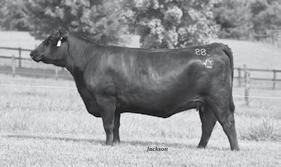
35 COWS WITH 26 CALVES: Many 3-n-1 packages. Ready to turn out on grass and go to work for you.
Goode Early Bird 8856: This outstanding donor cow sells along with her natural bull calf by NO SUBSTITUTE and 16 embryos: 4 each by NO SUBSTITUTE, SURPASS, ICONIC, WILLIAMS JONESBORO.
LIVE INTERNET BIDDING THROUGH TOP SHELF AUCTIONS TopShelf-Auctions.com or call Dan Wells (740) 505-3843

234th Sale Sponsored by the Central Kentucky Angus Association
GPS Address: 2286 Fork Church Road • Lancaster, KY 40444
Sale Day Phone: (859) 238.3195 or (859) 583.0364
Central Kentucky Angus Association Calendar
April 15: 57th Annual Spring Sale
Sale Manager: Dievert Sales Service







• Tim Dievert • 478 Dry Fork Road Danville, KY 40422 • (859) 238-3195 • Catalog at dievertsales.com


• 478 Dry Fork Road Danville, KY 40422
(859) 238-3195
tdievert@dievertsales.com
Catalog at dievertsales.com tdievert@dievertsales.com

September 9: Ladies Day - 2023
Like us on facebook
• Like us on facebook • Call for more details
Call for more details
November 9: 61st Annual Fall Female Sale
Auctioneer: Eddie Burks (270) 991-6398
Auctioneer: Eddie Burks (270) 991-6398
LIVE INTERNET BIDDING THROUGH TOP SHELF AUCTIONS TopShelf-Auctions.com or call Dan Wells (740) 505-3843 234th Sale Sponsored by the Central Kentucky Angus Association GPS Address: 2286 Fork Church Road • Lancaster, KY 40444 Sale Day Phone: (859) 238.3195 or (859) 583.0364 Sale Manager: Dievert Sales Service • Tim Dievert
•
•
•
•
Tim Dievert 478 Dry Fork Rd. Danville, KY 40422 859/238-3195 tdievert@dievertsales.com www.dievertsales.com 59TH ANNUAL FALL SALE SATURDAY, NOVEMBER 13 CKAA Sales Pavilion Danville, KY See ad on page 41
24 • Cow Country • April





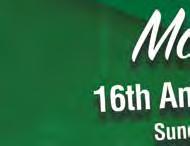

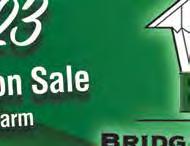



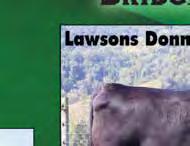



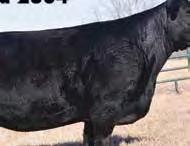

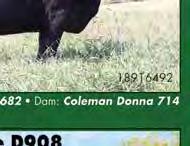
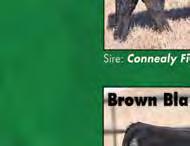
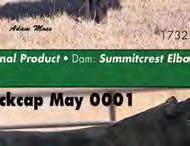

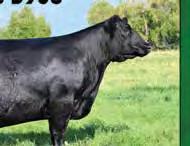



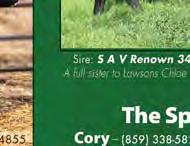
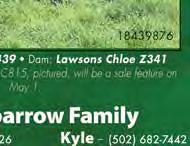
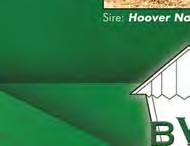


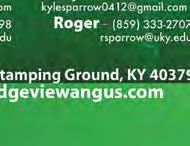




April • Cow Country • 25
Results from 500 Hay Samples: What They Do and Do Not Tell Us, and What We Can Do About It
Chris Teutsch UK Grain and Forage Center of Excellence, Princeton, Kentucky

Last fall we analyzed almost 500 hay samples as part of the Eastern Kentucky Hay Contest. A summary of the results can be found in Table 1. So here is what we found:
• Crude protein (3.2 to 21.7%) and total digestible nutrients (41.8 to 68.3%) varied widely









• 6% of the hay samples contained less than 50% TDN
• 4% of the hay samples contained less than 8% crude protein
• Only 57 samples or 11% contained enough energy to meet the requirements of a beef cow at peak lactation
• Only 268 samples or 54% would meet the protein requirements of a beef cow at peak lactation
• 477 samples or 96% contained enough protein to meet the needs of a dry pregnant cow
• 468 samples or 94% contained enough energy to meet the requirements of a dry pregnant cow
So, what does all of this tell us? I guess the biggest take home for me as forage specialist is that I have done a poor job helping people make better quality hay! For you as a cattle producer, the results of these 500 samples tells us that if you are feeding hay to lactating cows, you will likely need to provide some type of supplement to keep cows from loosing condition, especially rst calf heifers that are trying to grow and feed a calf.
So, what don’t these results tell us? Since there was such wide variation in both crude protein and energy for the hay samples in this dataset, no recommendations can be made on what or how much to supplement.
To make this type of recommendation, you will need to sample the hay lots (one cutting from one eld) that you will be feeding (see AGR-257 Hay Sampling Strategies for Getting a Good Sample). Once you have the results in hand, then a supplementation program can be designed by either working your local extension agent or veterinarian or by using the UK Beef Cow Forage Supplementation Tool.
UK Beef Cow Forage Supplementation Tool: An Example
For this example, we will use the “average” crude protein, neutral detergent ber, and total digestible nutrients for the 500 hay samples that were tested as part of the 2022 Eastern Kentucky Hay Contest (Table 1) and assume an as fed dry matter of 12%. When we compare the average values in Table 1 to the nutrient requirements of a lactating brood cow (Table 2), it becomes apparent that this hay will require supplementation. e question
then becomes what type of supplement and how much? is can be determined by using the UK Beef Cow Forage Supplement Tool. is application can be used on-line or downloaded to your smart phone. It allows you to enter the results from your forage test (dry matter, neutral detergent ber, crude protein, and total digestible nutrients) and gives you a range of supplement options and how much of each supplement must be fed to meet the cow’s nutritional requirements at a given stage of production (Table 3). e UK Beef Cow Forage Supplement Tool can be found on-line at http://forage-supplementtool.ca.uky.edu/.
When we enter the average values for crude protein, neutral detergent ber, and total digestible nutrients from Table 1, the application indicates that this hay would need to be supplemented with either 4.4 lb corn, 4.4 lb of soybean hulls, 4.4 lb of Corn Gluten Feed, or 4.1 lb of Distillers Dried Grain with Solubles on a daily basis (Table 4). When selecting a supplemental feed, it is important to consider local availability, how and where it will be stored, how it will be fed, how much can be safely fed, and of course how much it costs. It is important to realize that both hay testing and the UK Beef Cow Forage Supplement Tool are NOT perfect. ey are designed to get you in the ballpark and let you
26 • Cow Country • April
Table 2. Nutritional requirement of various livestock classes.
Animal Class Total Digestible Nutrients (%) Crude Protein (%) Growing Steer @ 1.5 lb/day 65 12 Growing Steer @ 1.7 lb/day 68 11 Lactating beef cow 60 11 Dry beef cow 50 8 Lamb finishing 70 12 Lactating ewe 65 13 Dry ewe 55 9 UK
Tool
Beef Cow Forage Supplementation
Constituent MinMax Avg MedSD Constituent Descrition Crude Protein (%) 6.1 22.211.611.20.9 Estimate of protein calculated by Total N x 6.25. Acid Detergent Fiber (%) 27.3 50.340.240.43.3 Chemical estimate of forage digestibility. Used to calculate energy. Neutral Detergent Fiber (%) 40.2 69.861.061.85.8 Chemical estimate of indigestible and slowly digestible fiber. Used to estimate DM intake. Ash (%) 2.7 23.68.07.82.0 Measure of total mineral content. Used as an indicator of soil contamination. IVTDMD-48 Hr (%) 54.985.268.368.35.0 Amount of forage material digested after 30-hours in ruminal fluid. Total Digestible Nutrients (%) 44.169.855.455.23.7 Estimate of energy. Calculated using ADF. Used to balance rations. Relative Feed Value (%) 64.9152.489.186.813.4 Relative comparison of forage quality to alfalfa harvested at full bloom. Dry Matter intake (% of Body Wt) 1.63.02.01.90.2 Estimate of how much of given forage can be consumed. Estimated using NDF, DMI = 120/NDF. 26 • Cow Country • April
Table 1. Summary of Eastern Kentucky Hay contest forage quality results. Samples were collected by extension agents, dried in a forced air oven, ground to pass through a 1 mm screen, and predicted using a near infrared spectroscopy.
Using UK Beef Cow Forage Supplementation Tool
1. Obtain a representative forage sample and send to NFTA certified lab.
2. From the test results enter DM, CP, NDF, and TDN (all on a DM basis) into the supplementation tool.

3. Select the stage of production from the drop down menu.
4. Select the supplements that you have available or just click the “Select All” button.
5. Click on the “Calculate” button.
6. View the results and select the appropriate supplement. Note: This NOT ration balancing software. Consult your local extension office or a trained nutritionist for help with formulating complete rations.

know if there is going to be a real problem with the hay that you are feeding. e true test is how your cows perform on a given hay lot. Sometimes when you look at your cows it is hard to see loss of condition from day to day. It may be a good idea to take some good quality photos at several times during the hay feeding season to document and compare changes in body condition.
Lastly, it is always a good idea to run your forage testing results by your local extension agent, veterinarian, or nutritionist. When it comes to hay feeding, it is important to be proactive rather than reactive. It is always easier to maintain condition rather than try to put it back on. So, make sure to test your hay and supplement accordingly before your cows lose condition and come up open.
Improving Hay Quality
If you nd the quality of your hay to be below “average” and/or you are tired of buying and feeding supplements, then it may be a good time to think about steps that you can take this spring to improve your hay quality. Below is a short list of things that you can implement to improve hay quality on your farm.
• Fertilize and lime according to soil test. A balanced fertility program is essential for optimizing hay yield and quality. Phosphorus, potassium, and lime should be applied according to soil test results. Avoid using “complete” fertilizers such as 10-10-10. ese fertilizers commonly over apply phosphorus and under apply potash.
• Apply nitrogen early to promote rapid spring growth. Applying 80 lb N/A in mid- to late March will promote early growth in hay meadows, resulting in higher rst harvest yields with improved crude protein values.
• Harvest at the boot stage. e single most important factor impacting forage quality is stage of maturity at harvest. Hay elds should be mowed as soon as the grass reaches the late boot-stage. e boot stage
occurs when the sheath of the ag leaf swells just prior to the emergence of the seed head. By making the rst cutting in a timely manner, we will have time to make a leafy second cutting just prior to the summer months.
• Mow early in day. Some studies have shown that sugars tend to be highest in late a ernoon, making this the optimal time of day to cut. However, in high rainfall environment like Kentucky, maximizing curing time is the highest priority. erefore, hay should be mowed in mid to late morning a er the dew has dried o .
• Use mower-conditioner. Conditioning the stems allows moisture to escape at a faster rate. is shortens curing time and improves your chances of avoiding rain. Conditioning is especially important for rst cutting grasses, summer annual grasses, and legumes, all of which tend to have larger stems.
• Set swath on mower-conditioner to the widest possible setting. Maximizing the swath width decreases curing or wilting time by exposing a larger portion of the forage to direct sunlight.
• Rake or ted at 40-50% moisture content. Raking and tedding the forage while it is still pliable helps to reduce leaf loss and maintain forage quality. Once the moisture content is below 40%, leaf loss increases, especially in legumes such as alfalfa and clover.
• Bale at 18-20% moisture. Baling in this moisture range inhibits mold growth and reduces heating. Avoid baling hay that is excessively dry due to high levels of leaf loss and hay that is above 20% moisture due to heating and potential hay res.
• Store dry hay under cover and o the ground. Protecting hay from weathering
CONTINUED ON PAGE 28
April • Cow Country • 27
Table 3. Steps for utilizing UK Beef Cow Forage Supplement Tool. Access the tool by scanning the QR code on page 26.
2 3 4 5
Table 4. Results from the UK Beef Cow Forage Supplement Tool for the “average” of the 500 hay samples analyzed as part of the 2022 Eastern Kentucky Hay Contest
UPCOMING EVENTS
Kentucky Fencing Schools Scottsville, KY on April 11, 2023 • Richmond, KY on April 13, 2023
Kentucky Beginning Grazing School Kentucky Soybean Board Office, Princeton KY on April 25 & 26
More information can be found by going to the Kentucky Forages Extension Webpage
FEATURED PUBLICATION
Understanding Forage Quality by Don Ball, Mike Collins, Garry Lace eld, Neal Martin, David Mertens, Ken Olson, Dan Putnam, Dan Undersander, and Mike Wolf. https://forages.ca.uky.edu/ les/ foragequality.pdf
FEATURED VIDEO
Converting High Quality Forage into Haylage: A Research Update by Jimmy Henning. This presentation was given as part of the 2022 Alfalfa and Stored Forage Conference, Conserving High Quality Forage as Baleage, that was held in Bowling Green, KY on February 24, 2022.
https://www.youtube.com/@KYForages
FENCING TIP
Always use underground cable designed for electric fencing and place it in protective tubing. It is very important to only use underground cable that is designed for electric fence. Never use any product that is intended for residential use. Whenever a cable carrying current is run under the ground, always place it in some type of pipe or conduit that will protect it from future damage. Wires going under gates should be buried to a depth of approximately 1 foot.
FORAGE MANAGEMENT TIPS
• Graze winter annuals.
• Flash graze paddocks that were frosted with clover.
• Allow calves and lambs to creep graze.
• As pasture growth begins, rotate through pastures quickly to keep up with initial growth.
• As pasture exceeds the needs of grazing livestock, remove some pastures from the rotation and allow growth to accumulate for hay or silage harvest.
• Get equipment ready to harvest hay at the late boot stage to early head stage top optimize yield and forage quality.
• Determine the need for and prepare to plant warm-season annuals.
CONTINUED FROM PAGE 27
helps to reduce dry matter losses and maintain forage quality. Much of the weathering damage is a result of the hay bale wicking moisture up from the ground. So, storing hay o the ground can greatly reduce deterioration.
Allison
• Consider using baleage. e biggest advantage of baleage is the shortened period between mowing and baling. In many cases, hay can be mowed one day and baled the next. is facilitates harvesting hay at the correct stage of growth, the NUMBER ONE factor impacting forage quality. To learn more about baleage see AGR-235 Baleage: Frequently Asked Questions.
If you need help with hay sampling or interpreting your hay testing results, make sure and contact your local extension agent. Forage testing is available from several commercial labs and the Kentucky Department of Agriculture. e Kentucky Department of Agriculture o ers a standard forage analysis to Kentucky producers for a reduced cost. More information on this program can be found at http://www.kyagr. com/marketing/forage-program.html. Make sure and use a lab that has been certi ed for accuracy and precision by the National Forage Testing Association. A list of certi ed labs can be found at NFTA Certi ed Labs.
Charolais Breeder
Allison Charolais
Charolais Breeder Since 1962 • Bulls Available
Ø Bull calves out of HCR Answer HCR SPIRIT 4007.
CHAROLAIS
Ø Bull calves out of HCR Answer 2042 and HCR SPIRIT 4007.
Ø Bull calves out of HCR Answer 2042 and HCR SPIRIT 4007.
Ø Bred for calving ease and growth.
Ø Bred for calving ease and growth.
Ø Bulls for both purebred and commercial breeders.
Ø Bulls for both purebred and commercial


Ø Bred for calving ease and growth.
Ø Yearlings and two-year-olds available.
Ø Yearlings and two-year-olds available.
CHAROLAIS BULLS FOR PUREBRED BREEDERS AND COMMERCIAL BREEDERS
Ø Bulls for both purebred and commercial breeders.
Ø Bred heifers to calve in fall available.
Ø Bred heifers to calve in fall available.
Ø Yearlings and two-year-olds available.
John Allison, Owner 545 Eminence Road New Castle, KY 40050 502-220-3170
John Allison, Owner
David Carter, Farm Manager 502-706-0075
Ø Bred heifers to calve in fall available.
John Allison, Owner 545 Eminence Road New Castle, KY 40050 502-220-3170
John Allison, Owner 545 Eminence Road New Castle, KY 40050 502-220-3170
John Allison 545 Eminence Road New Castle, KY 40050 (502) 220-3170
David Carter, 502-706-0075
David Carter, Farm Manager 502-706-0075
Registered South Poll bull with papers available for tranfer. Louie is easy to work, has been a solid producer for us and is only 4 years old
Contact Prince Dinger, Nicholasville, Kentucky. springwaterbeef@gmx.com 859-221-3519

28 • Cow Country • April Graham Good Deals A.W. GRAHAM LUMBER LLC Website: www.grahamlumber.com Phone: 1-877-845-9663 -Log Cabin Siding Wood & Vinyl -1x6 & 1x8 T&G Knotty Pine -2x6 T&G SYP & Treated -6” & 8” Cedar Bevel Siding -Framing & Treated Lumber -Rebar & Concrete Wire -Fence Post & Fence boards -Wood Barn Siding -Used Guardrail -20’ & 40’ Used Cargo Containers OUR DIRT CHEAP PRICES ARE POSTED ON OUR WEBSITE OR CALL FOR A DELIVERED PRICE TO YOUR LOCATION
BULLS & HEIFERS AVAILABLE
Allison Charolais
•
Since
Bulls Available
Charolais
•
Charolais Breeder Since 1962
Bulls Available
The main reason we’re in the MAINE business
PRODUCTION
Full Blood Bulls: 100% - Priced for Herd Builder Producers
Reg# 491147 – BNT Ellis – Tag #121E, Full Blood (100%) - $3,000
Reg# 500598 – BNT Grit (Embryo) – Tag #127G, Full Blood (100%)
Reg# 500598 – BNT Grant (Embryo) – Tag #110G (embryo brother to Grit)
Both are Coco Cola sons, $4500 your choice
Reg# 500596 – BNT Garth – Tag #118G, Full Blood (100%) - $3000
Talon is a moderate framed fullblood Maine that you can use to infuse some fresh genetics into your herd. Bently’s have been in the Maine business for 30+ years and anyone who’s seen Talon says he’s a great fullblood. Fullblood Bull Herd Sire – Grass Fed – Made right in Kentucky. He brings a lot to the table and makes his calves great. A certified sire from a certified herd.
Purebred Bulls: Black in color/75% plus – Ready for work
Reg# 507360 – BNT Gentry – Tag #419G, Purebred - $2,500
Reg# 506611 – BNT Gatsby – Tag #410G, Purebred - $2,500
Bulls are ready for this season – priced at farm – with registration transfers.
Selection available 3/1/23 – all animals are subject to sell as of this date.
Maine-Anjou Cattle




Full Blood/High Percentage
100%...............62.5%
Red/White – Black
FOR SALE
Priced right for the commercial market
Cows – Heifers
Registration – Transfer • Health Certificates
Bulls
For Sale – FOB – Farm
Richmond, KY • 859-200-2414 • kirk@mis.net

DOB: 9/11/2007 Horn: H Color: R TH: Free PHA: Free Pct Maine: 100% Birth Weight: 76
BWWWYWMilk 4.0.3747.5.3190.0.3026.4.23
SAV Elation 7899
The Beef Checkoff and Lab-Grown Protein
Greg Hanes CEO, Cattlemen’s Beef Board
As the fortunes of “plant-based meat” companies appear to be in decline recently, another competitor to beef raised on farms and ranches is starting to garner more headlines. “Lab-grown” or “cell-cultured meat” seems to be popping up here and there. Seeing these articles, some producers have expressed concern to me that the Beef Checko may begin to promote this “lab-grown” protein. Based on the law, my answer to them is always the same – no way!
Regardless of how these lab-grown products will be categorized, the Beef Checko will not be promoting them. Why? It all goes back to the federal law that created and controls the Beef Checko . In this law, called the Beef Promotion and Research Act (the Act), there are very clear de nitions relative to the Checko program and what it can and can’t do.
e Act speci cally de nes three important terms: “beef”, “beef products”, and “cattle”:
De nition #1: “beef” as “ esh from cattle”
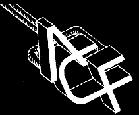
De nition #2: “Beef products” are “edible products produced in whole or in part from beef”
De nition #3: “cattle” are de ned as “live domesticated bovine animals”
e Act goes on to note that the Beef Checko can only be used for promotion, advertising, research and consumer and industry information programs, focused solely on “beef and beef products,” and to support the beef industry.
ese de nitions for both beef and beef products as coming directly from the esh of cattle (and cattle are live animals) are key, as lab-grown protein does not meet these established descriptions. In addition, no Checko dollars will be collected from any of these cell-based products. Checko assessments are based on live cattle or imported beef and beef products originating
from live cattle. ere are no provisions in the federal Checko law to collect dollars from lab-grown meat to be used in our program. Keep in mind there is one more check and balance to ensure no Beef Checko dollars are spent promoting a product that does not generate assessments on behalf of the Checko program. According to e Act, any programs funded by national Beef Checko dollars must be approved by the Beef Promotion Operating Committee (BPOC), comprised of “cattle producers and importers”. Non-assessment payers are not eligible to become CBB Board or BPOC members, and would not make these important funding decisions. We stand by those who pay into our longstanding program and will continue to take our legal and duciary responsibilities in upholding the law with the same continued commitment we use every day - now and in the future.
Amburgey Charolais Farm
Annual Bull & Female Sale & Herd Reduction Sale
Saturday, April 8, 2023 • 1 PM
Followed with the Commercial Cow Sale Blue Grass Stockyards East, Mt. Sterling, KY (1/2 mile off I-64 at exit 113)
Performance tested, good disposition, semen checked Bred
For More Information Contact:

30 • Cow Country • April
Bulls
Charolais
& Open Heifers Selling: Robert Amburgey 3171 Camargo Road Mt. Sterling, KY 40353 (859) 498-2764 Home (859) 404-3751 Mobile Blue Grass Stockyards East Jeff Copher (859) 229-7587

April • Cow Country • 31
Bovine Beauties
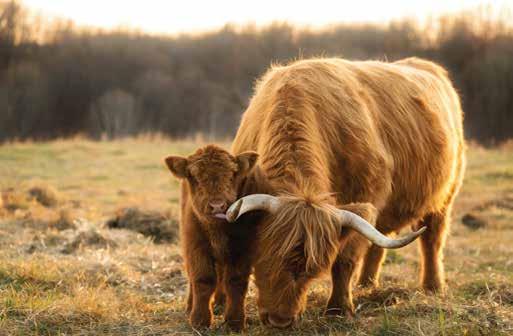

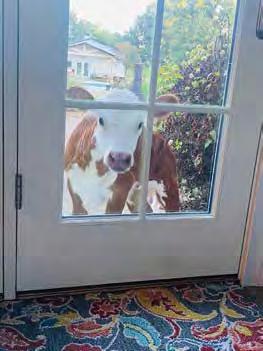
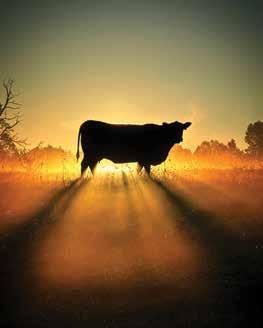
TOP SCENES
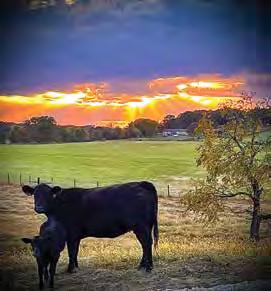
32 • Cow Country • April
2 3 4 5 1
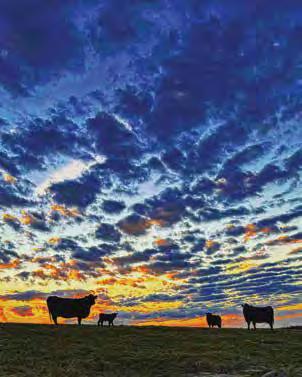

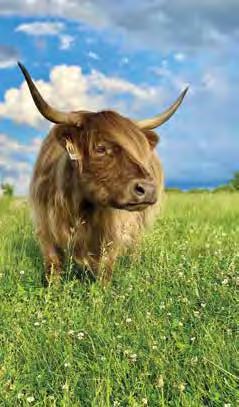
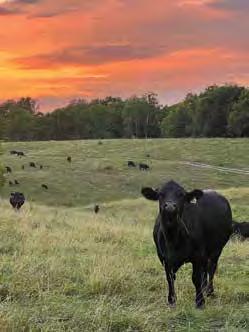
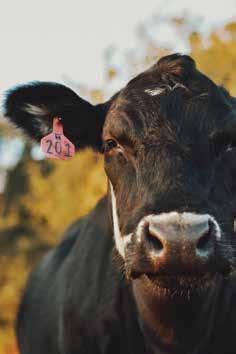
April • Cow Country • 33
1. Megan Tindle Henry County
2. Tiffany Perkins Daviess County
3. Elli Ramey Pendleton County
4. Addison Staton Bath County
5. Nikki Smith Casey County
6. Nikki Smith Casey County
7. Addison Staton Bath County
8. Kristin Carmack Shelby County
9. Holly Tucker Shelby County
6 7 8 9 10
10. McKenzie Hays Madison County
Bovine Beauties TOP PEOPLE
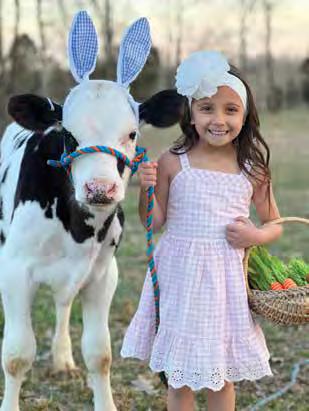


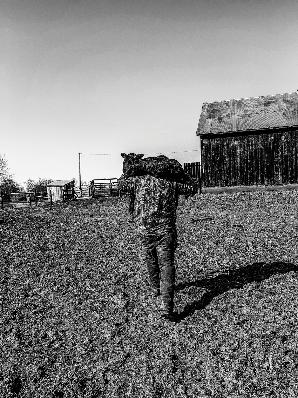
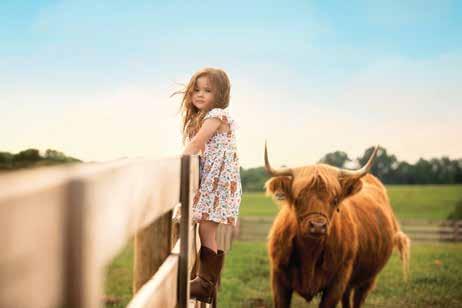
34 • Cow Country • April
1 2 3 4 5
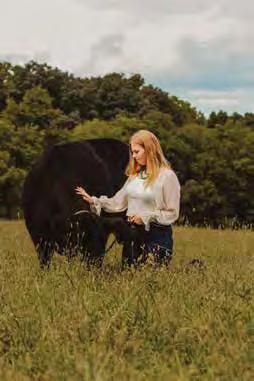






April • Cow Country • 35
1. Megan Tindle Henry County
2. LaShannon Spencer Montgomery County
3. Courtney Scott Bourbon County
4. Layla Dailey Harrison County
5. Kati Stevens Ohio County
6. Henry Ferguson Wolfe County
7. Elli Ramey Pendleton County
8. Britney Estes Clark County
9. Laura Jackson Bourbon County
6
8 9 10
10. LaShannon Spencer Montgomery County
7
Thank you to all participants!
See more submissions on our Facebook page and in future issues of Cow Country!

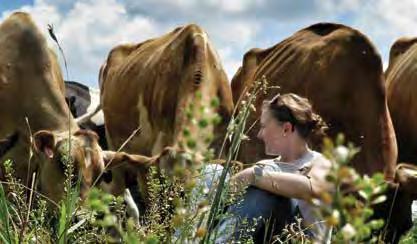

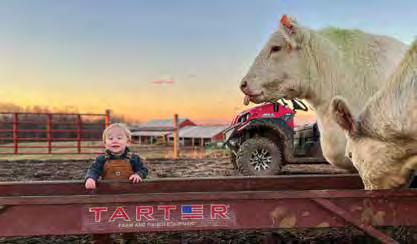



36 • Cow Country • April
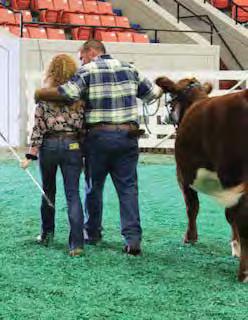

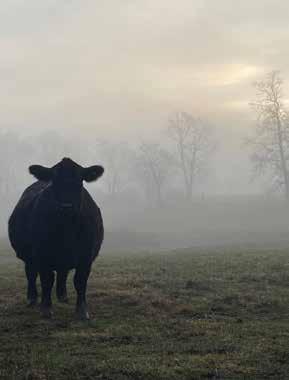



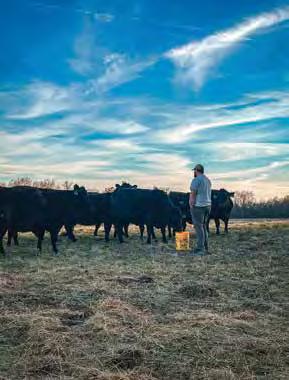

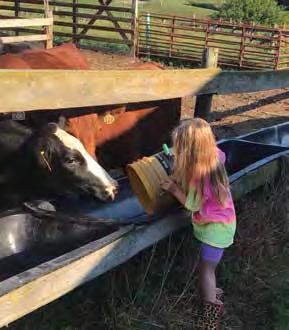
April • Cow Country • 37
To Graze or Not to Graze?
Brittany Davis Ph.D., Research Animal Scientist
Jennifer Weinert-Nelson Ph.D.; Animal Scientist Research Associate
Tracy Hamilton Agriculture Research Technician
It has been a very interesting year as far as winter weather, or the lack thereof in the state of Kentucky. We started with the late December polar plunge leaving most livestock producers thinking it was going to be a long winter of frozen automatic waterers and hoping there would be enough hay from an already pretty tight supply. Fortunately, the pattern subsided and since then we have had many sunny and very windy days with above normal temperatures for the season. With warmer temperatures has come a little earlier start to the growing season for most perennial plants including our pastures. Grass has been greening up since the end of February and most of us are ready to park our tractors and take advantage of some
early grazing opportunities. Our cattle are also noticing the green, green grass and are demanding access. Every cattle producer has their own strategies of determining when it is time to graze in the Spring, and there is no right or wrong way. However, there are some pasture and animal considerations that should be acknowledged when making these management decisions.
Pasture Considerations


at rst glimpse of green grass in the spring a er long winter months is a beautiful sight! It signals that the need for feeding supplemental forage is coming to an end and grazing is right around the corner. However, spring pasture management can present a number of challenges, and the decisions we make now
can impact the productivity and quality of our pastures later in the grazing season and even in future years.
Avoiding overgrazing is one of the primary challenges associated with spring pasture management (Figure 1). Defoliation during overgrazing removes a large percentage of the stem and leaf material available to perform photosynthesis in the plant. ose green parts of the plant act as solar panels capturing sunlight and converting it into energy. Removing too much plant material through overgrazing can reduce photosynthetic e ciency and capacity, limiting the ability of pasture grasses to produce energy needed for re-growth and lowering pasture yield in later months of the grazing season. In the spring, the risk of overgrazing increases if pastures are grazed too early before enough forage has accumulated and animals quickly deplete the available grass. Fluctuations in weather can also create potential for overgrazing. In some years, early spring temperatures are warm (as they have been this spring), but that does not mean that above average (or even average) conditions will continue over the course of the full spring season. If cooler temperatures

38 • Cow Country • April RUMINATE ON THIS
a b c
Figure 1. (a) Overgrazing - Where is my grass?, (b) Optimal Grazing - Happy cows grazing pasture, and (c) Undergrazing - I can’t see my friends?
Figure 2. Dry matter content and water content in hay, early spring pasture, and spring pasture
Hay Spring Pasture Water Dry Matter Early Spring Pasture gases fibrous mat of long particles small particles in a liquid suspension
Figure 3. The rumen fiber mat is ESSENTIAL for rumen health. Lower fiber intake from early spring pasture reduces the fiber mat causing rumen disturbance
return later in spring, pasture growth will slow, and pastures that provided adequate forage during those earlier warmer months may no longer be able to support your herd.
In addition to depressing pasture productivity, overgrazing can lead to a reduction in vegetative cover and a greater percentage of bare ground in pastures. Decreased competitiveness and persistence of grasses due to overgrazing can leave pastures vulnerable to weed invasion. Not only are weeds often an eyesore, but they can decrease the overall nutritional quality of pastures, and some can even be toxic to grazing cattle. Once weeds have infiltrated a pasture stand, eliminating them from pastures can be time-consuming and costly.
Decreased vegetative cover due to overgrazing can also be detrimental to soil health. Impacts of overgrazing on pasture soils in the spring are compounded by characteristically wet weather conditions. Grasses growing in wet and muddy soils have less wear tolerance and are prone to trampling. These combined stressors can have negative environmental implications. When vegetative cover in pastures is reduced below 70%, there is a greater potential for soil erosion and nutrient runoff. It is difficult for pastures to recover from these effects of overgrazing without reseeding or renovation, which can confer significant costs to producers.
Animal Considerations
Early Spring grass is like candy to cows. They will eat and eat and eat for several days until they have a stomachache just like we do when faced with an endless supply of our favorite sweet treat. It is true that cows are typically able to regulate their intake to avoid gut disturbance, toxins, or disease, but early Spring grass is the exception to that rule. I think we are all familiar with the geyser of wet green feces coming from the rear of our cows after transition to grass. Hopefully, for your sake, you weren’t standing too close when observing this! The facts are that there are several nutrition, performance, and health challenges when transitioning from stored forages to lush Spring pastures that producers need to consider in our management decisions.
Lush green spring pasture is NOT a balanced diet. As perennial pastures break dormancy in the spring, we often see a rapid green up. Rapid grass growth requires fast nutrient and water uptake by the plant. As a result, our first spring pastures are quite different in nutrient and moisture content in comparison to the stored forages being fed through the winter and even what we typically expect from the same pastures later in the spring season. The
first grass growth can contain as high as 85% moisture and only 15% dry matter (DM; Figure 2). The DM portion includes ALL of the nutrients available to the animal including sugars, proteins, and fiber. In comparison, pasture grasses later in the Spring often provide 30% DM and stored forages like hay provide 85% DM. This dietary transition is probably one of the most dramatic a cow will face over the year and if managed incorrectly can dramatically impact rumen function and lead to loss of performance and even increase risk for disease.
Cattle appetite is limited to rumen capacity. The rumen is the largest digestive organ (20 – 30 gallons) in the cow’s body, but it still can only hold so much plant material. When cattle chow down on early spring pasture the rumen will fill up with water before they can consume enough to get the fiber and nutrients they need. If a 1200 lb cow needs to consume 2.5% of her body weight in pasture DM to meet her energy requirements she would normally consume 30 lb of pasture DM or 100 lb of fresh forage per day. In early spring, that same cow would have to consume double that or 200 lb of pasture to get to the same DM consumption. This is an impossible task for the cow and can lead to nutritional restrictions and decreased performance.
It is also important to note that nutrient composition is often unbalanced in spring pasture with higher protein, moderate energy, and low fiber. Balanced protein and energy in the diet are essential for supporting optimal animal health and performance. Adequate fiber intake is important for maintenance of the rumen fiber mat and rumination behavior. The rumen fiber mat is made up of long plant fiber material and microbes and is essential for maintaining a normal digestive passage rate to allow for optimum nutrient utilization (Figure 3). Without it, digesta passes too quickly through the gut resulting in decreased nutrient utilization, unsatisfied cows, and you guessed it – the dreaded fecal geysers. The fiber mat also stimulates rumination or cud chewing, allowing for saliva production that provides minerals and buffers that help to maintain a healthy rumen environment. These nutrient imbalances and limitations on DM and fiber are most concerning when cattle have increased nutrient demands like spring calving cows that not only have to produce milk to support their calf, but also maintain body condition for re-breeding or recently weaned calves from fall cows. Lack of fiber and nutrition can result in digestive disturbances, performance limitations (milk production, re-breeding, gain), metabolic issues, and even increased susceptibility to disease and parasites.
QUICK TIPS FOR TRANSITIONING FROM HAY TO EARLY SPRING PASTURE:
Be Patient: Initial grazing of forage should not start until plants are 8 –10 inches tall. Research has shown that >60% loss of total forage yield can occur if early spring grass is grazed too early. One week of early grazing in the spring can translate to 3 weeks of lost grazing in the fall. It just isn’t worth it.
Be Mindful of Overgrazing: Overgrazing early in the spring can also lead to decreased forage production later. Moving livestock through pastures a little faster allows for only a few inches of grazing at a time which prevents overgrazing and also will allow you to get through all your paddocks before pastures get too mature.
Supplement Fiber and Nutrition: Consider supplements to better meet nutrient requirements during transition. These can include concentrate and/or high Mg mineral supplements. If there is still residual dry grass from the fall (4 – 6 inches) there may already be enough fiber for your cattle to consume and balance the spring lush forages. If not, provide hay for a minimum of 2 weeks when transitioning to allow for adequate DM intake and to support a healthy and productive rumen and animal.
Respect Mother Nature: No matter how hard we try as producers to predict the future and support our cattle, the biggest challenge we encounter is Mother Nature. Don’t ever assume that green grass means winter is over. As we have experienced over the last few years, she always sends us a surprise when we least expect it. Always be prepared with a backup plan.
April • Cow Country • 39
Toxin Infested Fescue? WE CAN HELP!



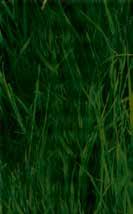
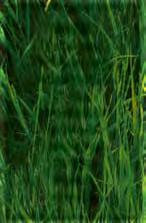




A three-year research study was conducted using Fescue 7 at Morehead State University. Researchers measured cow body condition scores, calf weights, hair shedding, body temperature, and cow behavior. Cows provided the Fescue 7 mineral had significantly better body condition scores, quicker hair shedding, lower body temperature and grazed more frequently during the heat of the day. We believe that our research shows that Fescue 7 mineral can be an effective tool in combating heat stress associated with fescue toxicosis.”
Dr. Patricia Harrelson Associate Professor of Animal Science at Morehead State University
Gro-Tec • Austin Stevens • Willy Campbell 1-800-535-3354 • (606) 748-9987 • www.gro-tec.com


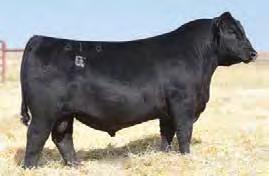
Fly control has never been easier.


“Some years ago, we lost almost an entire calf crop due to the fescue. Needless to say I was looking for answers. One thing I did was attend the Alliance for Grassland Renewal workshop and learned a lot of things, which we have instituted as common practices on our farm and farms we rent. However, I didn’t want to get rid of the Kentucky 31 because I’m a seedstock producer and I felt that if I did away with the Kentucky 31 I could possibly be selling cattle to people that couldn’t handle the hot grass. So I opted to just do a better job of managing the grass that covers most cattle country in my area. The second thing I did was look up a mineral salesman I had talked to a year prior by the name of George Speigelhalder. That conversation changed the landscape of our operation forever. He introduced me to Gro-Tec mineral and a product called Fescue 7. Without going into great detail this stuff is a gamechanger. Not only did it help tremendously with the fescue but it also cut down our pinkeye and foot rot problems. Sent our breed back rates on the high 90% range.”
Jason S Jefferson City, MO .,

Toxin Infested Fescue? WE





A three-year research study was conducted using Fescue 7 at Morehead State University. Researchers measured cow body condition scores, calf weights, hair shedding, body temperature, and cow behavior. Cows provided the Fescue 7 mineral had significantly better body condition scores, quicker hair shedding, lower body temperature and grazed more frequently during the heat of the day. We believe that our research shows that Fescue 7 mineral can be an effective tool in combating heat stress associated with fescue toxicosis.”
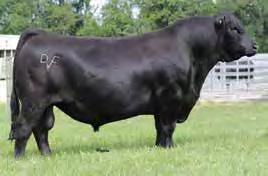 Dr. Patricia Harrelson Associate Professor of Animal Science at Morehead State University
Dr. Patricia Harrelson Associate Professor of Animal Science at Morehead State University

40 • Cow Country • April 22nd Annual Grass Time Partners Sale Monday, April 10 at 7pm Paris Stockyards FOR MORE INFORMATION AND SALE DAY PHONES John McDonald 859.404.1406 Jason Crowe 859.582.0761 Randel Arnett 859.585.2266 BULLS: Growth Fund GAR Home Town Tehama Patriarch DL Dually SAV Raindance E&B Plus One Coleman Regis Sitz Stellar Veracious Cowboy Up SALE DAY ADDRESS 1120 Millersburg Road • Paris, KY 40361 EXCELLENT GENETICS - PERFORMANCE - QUALITY PROGRAMS DEER VALLEY GROWTH FUND E&B PLUS ONE 55 REGISTERED ANGUS BULLS 30 REGISTERED ANGUS FEMALES 65 COMMERCIAL FEMALES
CAN HELP!
Gro-Tec • Austin Stevens • Willy Campbell 1-800-535-3354 • (606) 748-9987 • www.gro-tec.com available in Fescue 7, Stocker 7, and any other cattle mineral!



April • Cow Country • 41
ANGUS
WE HAVE
FOR YOU. Bridgeview Angus Bulls For Sale 570 Snavely Road • Stamping Ground, Kentucky 40379 50 REGISTERED ANGUS BULLS: 18 MONTHS OLD, BSE CHECKED • LOW BIRTH WEIGHT HEIFER ACCEPTABLE WITH EXPLOSIVE GROWTH TATTOO CED BW WW YW AI SIRED 115 10 +.3 68 132 REGIMENT 119 9 +1.0 66 121 TRUE NORTH 127 11 +1.6 69 124 KANSAS 134 13 -.1 76 135 ASHLAND 138 7 +1.0 75 133 PATRIARCH 140 10 +1.2 78 141 BLACK ONYX 142 10 +1.7 63 112 ALTERNATIVE 144 10 +.7 74 132 KANSAS 145 10 +.7 91 164 REGIMENT 147 14 0 76 128 RAWHIDE 150 11 +1.0 78 142 FIREBALL 151 13 -.3 66 114 UNIQUE HERE IS A SAMPLE OF BRIDGEVIEW ANGUS BULLS OFFERED PRIVATE TREATY All bulls
first 90 day breeding season guarantee! 570 Snavely Road • Stamping Ground, Kentucky 40379 FOR INFO CALL OR TEXT CORY 859-338-5826 KIP 859-608-7798 KYLE 502-682-7442 ROGER 859-333-2707
NEED A GOOD
BULL?
ONE
subject to
Cow-Calf Profitability Estimates for 2022 and 2023 (Spring Calving Herd)
Greg Halich, Kenny Burdine, and Jonathan Shepherd
The purpose of this article is to examine cow-calf profitability for a spring calving herd that sold weaned calves in the fall of 2022 and provide an estimate of profitability for the upcoming year, 2023. Table 1 summarizes estimated costs for a well-managed springcalving cowherd for 2022. Every operation is different, so producers should evaluate and modify these estimates to fit their situation (see Table 2). Note that in Table 1 we are not including depreciation or interest on equipment/fencing/facilities, as well as labor and land costs.
Calves are assumed to be weaned and sold at an average weight of 550 lbs. In the fourth quarter of 2022, steers in this weight range were selling for prices in the upper $160’s and heifers in the low $140’s, on a state average basis. Therefore, a steer / heifer average price of $1.55 per lb is used for the analysis, which was $0.15 per lb higher than last year. Calf prices have increased significantly since that time, but this analysis assumes that spring born calves are sold late in the same year. Weaning rate was estimated at 85%, meaning that it is expected that a calf will be weaned and sold from 85% of the cows that were exposed to the bull. Based on these assumptions and adjusted for the weaning rate, average calf revenue is $725 per cow. Cost-wise, the major changes for 2022 were significant increases in fertilizer and fuel prices. Nitrogen, potassium, and diesel fuel prices more than doubled between 2021 and 2022. The biggest impact that these had collectively was on hay production costs, but many other areas were impacted as well. However, general price increases were seen in almost all cost categories. These are all reflected in the cost estimates for 2022.
Pasture maintenance costs are assumed to be relatively low at $30 per acre and would include only basic cash costs of pasture clipping (fuel, maintenance, repairs), and a limited amount of reseeding, fertilizer, and fencing repairs. Cattle farmers who consistently apply large amounts of fertilizer to pasture ground would see much higher pasture maintenance costs. The pasture stocking rate is assumed to be 2.0 acres per cow, but this will vary greatly. Stocking rate impacts the number of grazing days and winter feeding days for the operation (i.e. high stocking rates will mean more hay feeding days), which has large implications for costs on a per cow basis.
These spring calving cows were assumed to use 2.5 tons of hay per cow, and the estimated cash cost of making this hay (fuel,
maintenance, repairs, supplies, fertilizer, etc.) was $55 per ton. Mineral cost is $35 per cow, veterinary / medicine costs $25, trucking costs $15, machinery cash costs for winter feeding and other miscellaneous jobs is $15, and other costs (insurance, property taxes, water, etc.) are $40. Breeding costs are $40 per cow and should include annual depreciation of the bull and bull maintenance costs, spread across the number of cows he services. Marketing costs are assumed to be $35 per cow (adjusted for the 85% calf crop) for average-sized farms selling in smaller lots. Larger operations would likely market cattle in larger groups and pay lower commission rates.
Breeding stock depreciation and interest are major costs that are often overlooked. They are generally not cash costs that need to be paid on a yearly basis, unless you have a loan on the cattle, but they are real costs that need to be paid at some point. As an example, assume that in a typical year bred heifers are valued at $1600, have eight productive years, and have a cull cow value of $850. The average yearly depreciation is calculated as follows:
$1600 bred heifer value
–$808 cull-cow value (adjusted for a 5% death loss)
$793 total depreciation
$793 depreciation / 8 productive years = $99 cow depreciation per year. The actual depreciation will vary across farms. When buying bred replacement heifers, the initial heifer value is clear. With farm-raised replacements, this cost should be the revenue foregone had the heifer been sold with the other calves, plus all expenses incurred (feed, breeding, pasture rent, etc.) to reach the same reproductive stage as a purchased bred heifer. At an average value of $1225 (halfway between bred heifer and cull value) over her lifespan on your farm, and assuming a 3.5% interest rate results in a $43/cow/year interest cost, or a total of $142/cow/year in combined depreciation and interest.
Note that based on the assumptions in our example, total specified expenses per cow are $550 and revenues per cow are $725. Thus, the estimated gross return is $175 per cow. At first glance, this positive return looks impressive, but is also misleading. A number of costs were intentionally excluded because they vary greatly across operations. Notice that no depreciation or interest on equipment/ fencing/facilities was included. Notice also that labor and land costs were also not included. Thus, the gross return needs to be adjusted by these costs to come up with a true
return to the farm.
Since these costs vary so much from one operation to the next, it may be helpful to pick a specific sized farm and provide estimates for these costs: a 40-cow operation that is producing its own hay and has all farming operations on its own land (80 acres of pasture and 30 acres of hay).
Assume this farm has on average $50K in equipment which depreciates roughly $1000 every year, or $25/cow/year in depreciation. At 4% interest, an additional cost of $2000 in interest per year, or $50/cow/year, would be realized. Assume also this farm has fencing, barns, working facilities, etc., with an initial value of $50K and a lifespan of 25 years. That would amount to $50/cow/year in depreciation and $25/cow/year in interest. If we have 2.0 acres of pasture and .75 acres of hay per cow, and value that at a land rent of $36/acre, that would be $100/cow/year in land rent. Assume also that we have determined we have $100/cow/year in labor, which would amount to $4000 total per year for the entire herd.
Summary of Additional Non-Cash Costs (40Cow Example Farm):
Equipment Depreciation $25/cow/year
Equipment Interest $50/cow/year
Fencing-Facilities Depreciation $50/cow/year
Fencing-Facilities Interest $25/cow/year
Land Rent $100/cow/year
Labor $100/cow/year
Total Additional Non-Cash Costs $350/cow/year
These non-cash costs add up to $350/cow/ year on our example farm: $150 per cow in depreciation/interest on equipment/fencing/ facilities and $200 per cow in land rent and labor. We encourage you to estimate these for your own operation, but the unfortunate reality is that they quickly add up on most farms. The $175/cow/year gross return over cash costs and cow depreciation does not look quite as good now. After adjusting for these other costs, the net return (all costs included) is –$175 per cow per year ($175 – $350), or –$7000 total for the 40-cow farm. Another way to look at this is to just include the depreciation and interest for equipment/ fencing/facilities ($150/cow/year), and not include land and labor ($200/cow/year). In this case, the return would increase to $25/ cow/year and would represent the farms return to land and labor. Did this farm actually lose money on a cash basis? No, not
42 • Cow Country • April ECONOMIC & POLICY UPDATE
if they are using their own labor and their land is paid for. But the farm also did not make a real pro t. is farm essentially paid the equipment/fencing/facilities depreciation and interest in full but only part of the labor-land cost: e farmer and the land worked for free roughly 7/8 of the time.
ese numbers will vary across operations, so estimating your own cost structure is extremely important. Our guess is that compared to our example farm, there are far more cow-calf operations of similar size with a higher cost structure than there are operations with a lower cost structure in Kentucky. Put simply, well-managed spring calving herds were likely covering all cash costs, breeding stock depreciation/interest, and depreciation and interest on equipment/fencing/facilities, but were not generating much of a return on their labor or land this last year.
Readers can use Table 2 to modify the analysis based on their cost structure and calf prices for 2022. It uses all costs except for land and labor, so the table shows a return to land and labor using the cost structure in our example. As an example, we used $1.55/lb in our base scenario as the steer/heifer price for 2022. Given the cost structure we used ($0 change on the le hand side of the table), the expected return to land and labor is $25/cow/year, just as was previously described. If a cattle farmer sold their calves for an average price of $1.55/lb but had a $50/cow/year cheaper cost structure (-$50 change on the le hand side of the table), their expected return to land and
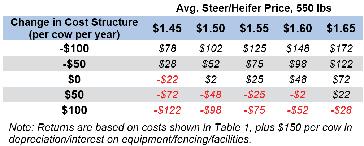
management would increase to $75/cow/year. If another cattle farmer sold their calves for an average price of $1.60/lb calf, and had a $50/ cow/year cheaper cost structure (-$50 on the le hand side), their expected return to land and management would increase to $98/cow/ year. In this last example, they fully covered their depreciation/interest on all equipment and facilities, fully covered their land rent, but worked for free.
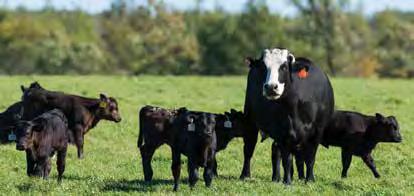

Discussion
Even though calf prices were better in 2022 compared to 2021 (+$.15/lb), projected pro tability is lower due to increases in cash costs ($94/cow higher in 2022). Again, this was largely driven by signi cant increases in fertilizer costs, and to a lesser degree, fuel costs. Farms that rely less on commercial fertilizer would have had better pro tability than what we show here.
We also assumed an average-sized cattle farm that would sell at the higher commission rate and would likely get a lower sales price for calves compared to larger operations. Larger operations that can sell at the lower commission rate and generally get better calf prices for selling in larger lots would have had better pro tability than what we show here. Finally, one important assumption that we made that would change on some farms relates to culling open cows. Our assumption for an average-sized farm was that they would not pregnancy-check cows in the fall and would thus not cull open cows at that time.
The Agricultural Economics Department publishes the Economic and Policy Update towards the end of each month. Each issue features articles written by extension personnel within the department and other experts across the country.
Farms that are able to cull open cows in the fall at weaning time and avoid the expense of wintering them would have had better pro tability than what we show here. ese open cows would be replaced with bred heifers that would incur wintering costs, but would be very likely to produce a calf the following spring.
2023 Outlook
ere is good reason to expect higher prices for 2023, and calf prices have already risen quite a bit since last fall. e size of the US cowherd continues to shrink and is 9% smaller than it was in 2019. Additionally, beef exports set a record in 2021 and broke that record again in 2022. While uncertainty exists, 2023 is likely to be the best calf market we have seen since 2015.
Our best guess for fall 2023 prices for that same 550 lb steer/heifer are in the $1.85-1.95/ lb range, or $1.90/lb average. Spring prices are likely to be much higher than this, but we do expect calf prices to decline seasonally by fall. Reducing the costs slightly for fertilizer for hay/pasture and fuel, but increasing marketing costs and the amount of hay fed in 2023 (due to drought conditions during the 2022 growing season), results in a return to land and labor of $198/cow/year. Recall that in our example we had estimated $200 per cow in land rent and labor. us we would essentially fully cover our land and labor costs
CONTINUED ON PAGE 44
Topics will vary greatly but regularly include marketing, management, policy, natural resources, and rural development issues. If you would like to recieve this newsletter by email, please contact Kenny Burdine at kburdine@uky.edu

You can also view current and past issues online at https://bit.ly/2PoHsZj
Co-editors: Kenny Burdine, Alison Davis, and Greg Halich
April • Cow Country • 43
Table 1. Estimated Gross Return to Spring Calving Cow-calf Operation 2022
Table 2. Estimated Return to Land and Labor (per cow) to Spring Calving Cow-Calf Operation given Changes in Cost Structure and Calf Prices
CONTINUED FROM PAGE 43
in 2023 in our example farm, which would be a considerable improvement over 2022. Fertilizer prices have come down in 2023 compared to the unprecedented high levels in 2022. However, they are still roughly 50% higher than pre-2022 levels. In this analysis, we assumed a below-average fertilizer dependency to sustain a beef cow unit. Farms that use higher levels of fertilizer will have lower pro ts than we show here. us managing around these high fertilizer prices is still of paramount importance. For practical strategies to reduce or eliminate fertilizer use on cattle farms see the February 2023 video “Strategies to Reduce Fertilizer Use on Cattle Farms.”
e article “Reducing Your Dependency on Commercial Fertilizers - Strategies for Cattle Farms in 2022 and Beyond” is also available to read.
Market fundamentals suggest that calf prices should be at very high levels in 2023 and the same should largely hold in 2024. Still, calf prices are only part of the story, and we hope this article highlights the importance of cost control. Ideally, costs for a given operation would be structured such that attractive pro ts can be had at these high calf prices. However, there will be farms that will still struggle to cover all their costs, even with the higher calf revenues.
Many farms will be tempted to increase the size of their cow herds in response to these high calf prices. However, two cautionary red ags should be waved at this point: 1) During the last time of extremely high calf prices (20142015), bred heifer prices got bid up to the point where they would only pencil out with continued high calf prices. ose calf prices collapsed quickly leaving those that expanded with low revenues to support paying for those high-priced breeding stock. 2) Concentrating
on high-priced calves and ways to produce more of them takes away focus from reducing costs that are out of control on many farms. If you are not generating a true pro t (above what would give you and your land a fair return) in the current market, you are almost certain to be in the red when calf prices come back down to more normal levels. Most farms would be better served to concentrate on reducing their cost structure to better position themselves for the lean times that are almost sure to follow.
Greg Halich is an Associate Extension Professor in Farm Management Economics for both cattle and grain production and can be reached at Greg.Halich@uky.edu or 859-257-8841. Kenny Burdine is an Extension Professor in Livestock Marketing and Management and can be reached at kburdine@uky.edu or 859-257-7273. Jonathan Shepherd is an Extension Specialist in Farm Management and can be reached at jdshepherd@uky.edu or (859) 218-4395.
Changes in Kentucky Sales Tax That Apply to Farming
Jerry Pierce Department of Agricultural Economics
Legislation went into e ect on the rst of 2023 that made many services subject to Kentucky’s 6% sales tax. One change was to the quali cations for residential use exemption from sales tax on utilities. As a result, Kentucky sales tax will be charged for utility services furnished to any location that is not your place of domicile, even if it was formally classi ed as residential.
e Agriculture Exemption License Number makes quali ed farms exempt from sales tax on natural gas, LP, and water used exclusively and directly in quali ed farming operations, but not electricity. See the article on Kentucky Sales Tax on Utilities.

ere are other changes that apply to farming: “Marketing Services.” Sales tax now applies to “developing marketing objectives and policies, sales forecasting, new product developing and
pricing, licensing, and franchise planning.” If you pay for things like marketing advice, strategies, advertising, and sales services expect to see KY sales tax added on to your bill. Extended warranty services purchased separately are now subject to sales tax. An extended warranty, service agreement, or maintenance agreement provides prolonged coverage in addition to the standard warranty. Sales tax now applies to an extended warranty on farm machinery and equipment, even though the purchase price of the property itself is exempt. is also includes extended warranty contracts for land, buildings, and improvements.
Services performed by veterinarians and veterinary practices are now taxable. However, services for horses and food animals, like cattle, are exempt.
ere is now a sales tax exemption for drugs and over-the-counter medications “that are purchased by a person regularly engaged in the business of farming and used in the treatment of cattle, sheep, goats, swine, poultry, ratite birds, llamas, alpacas, bu alo, aquatic organisms, or cervids.”
Security system monitoring services for home and business are subject to sales tax.
Electric Vehicle (EV) power distributed in Kentucky by electric charging stations will be taxed at $0.03 per kilowatt hour, including stations located on state property. Registration of a new EV and annual renewal registration fees now apply, as well.
For more information and a list of other services covered see Kentucky Sales Tax Facts from the Kentucky Department of Revenue.
44 • Cow Country • April ECONOMIC & POLICY UPDATE (continued)



April • Cow Country • 45
Spread with Style
Proven Donor Sells!
Herd Bull Prospect Sells



Donor Prospect Sells



ROY AND MARIE BARNES, OWNERS KEVIN ATKINS 256.706.9405 1644 PIEDMONT HWY • CEDARTOWN, GA 30125 KEVINATKINS01@GMAIL.COM • WWW.BARNESHEREFORDS.ORG LAYTON AUCTION SERVICE Dustin Layton 405.464.2455 Chisum Kinder 405.747.4683 www.laytonauction.com Sale will be broadcast live through LiveAuctions.TV TO REQUEST A SALE CATALOG CONTACT THE OWNERS OR SALE MANAGER Carter St. John 205-705-4041 Feature Yearling Open Heifer CED 5.3 BW 0.6 WW 66 YW 109 MILK 35 UDDR 1.30 TEAT 1.40 REA 0.49 MARB 0.22 RMB G15 SOUTHERN BELLE 075K reg. P44326878 - dob. 2/4/22 Loewen Grady B42 G15 ET X DCF 810F Ms Excel 004H CED 3.7, BW 2.2 WW 62 YW 106 MILK 33 UDDR 1.20 TEAT 1.30 REA 0.43 MARB 0.18 RMB Z426 SOUTHERN BELLE 343F reg. P43901809 - dob. 2/14/18 sire. Mohican THM Excede Z246 dam.Gerber Z311 Gracious D037
CED -1.1 BW 3.4 WW 73 YW 106 MILK 24 UDDR 1.40 TEAT 1.40 REA 0.95 MARB 0.36 RMB 4020 SOUTHERN BELLE 049E reg. P43773041 - dob. 1/18/17 sire. Innisfail WHR X651/723 4020 ET dam.RMB 122L Southern Bell 480B ET
87G 343F WALKOFF 169K reg. P44393179 - dob. 9/20/22
Z426
RMB 87G SOUTHERN BELLE 215K reg. P44403961 - dob. 11/2/22 sire. 77 Walk Off 60D 87G dam.RMB 4020 Southern Belle 049E CED 9.1 BW 0.4 WW 58 YW 98 MILK 31 UDDR 1.30 TEAT 1.40 REA 0.59 MARB 0.30 CED 0.2 BW 3.9 WW 71 YW 110 MILK 26 UDDR 1.40 TEAT 1.50 REA 0.85 MARB 0.32
RMB
sire. 77 Walk Off 60D 87G dam.RMB
Southern Belle 343F


2023 Beef Expo Sales Reach $780,000


FRANKFORT, Ky. (March 8, 2023) – e 2023











Kentucky Farm Bureau Beef Expo nished with more than $780,000 in total sales in the 37th edition of the event at the Kentucky Exposition Center during the rst weekend of March.
Total sales in 2023 were $781,410 a decrease of $147,590 compared to last year’s sales, but closer in line to 2021 sales which reached a little more than $770,000. In addition to total sales being down, the average sale also decreased slightly by $98 to $2,427 per lot, with 324 lots auctioned this year, nearly 50 less than 2022.



“Cattle is one of Kentucky’s top livestock and

























the Kentucky Farm Bureau Beef Expo is a place to showcase the fact that this state is still the largest beef cattle state east of the Mississippi River,” Kentucky Agriculture Commissioner Dr. Ryan Quarles said. “Cattle numbers are down this year, but that’s a trend we’re seeing nationwide. Tough weather events and high input costs combined to create a necessary culling of some cattle. But, we’re an agricultural state and the resiliency of our farmers will see them bounce back. is show is putting that resiliency and toughness center stage.”
Angus cattle brought an average of $3,232

per lot to lead all breeds. e sale topper was an $8,000 Hereford Female from Matheny Herefords Farm out of Mays Lick, Ky. e Beef Expo welcomed 15 states and eight breeds this year.
In the junior show, 378 cattle from 14 states passed through the show ring, including 190 from Kentucky. e judging contest attracted 115 participants.
e 2023 Beef Expo’s main sponsors were Kentucky Farm Bureau and the Kentucky Department of Agriculture.



48 • Cow Country • April
37TH ANNUAL BEEF SHOWCASE AVERAGE SALES SLIGHTLY DOWN FROM LAST YEAR
Cow-Calf Pairs • Bulls Bred & Open Heifers • Commercial Middle Tennessee Hereford Association, Inc. April 22, 2023 • 11:30 a.m. CT Kentucky-Tennessee Livestock Market Cross Plains, Tennessee 2023Spr Spring Sale 76 Lots Online Bidding www.cowbuyer.com Contact Kathryn Ingram at katingram.123@gmail.com or (423) 337-1383 for additional information. Catalog available for viewing at www.hereford.org
Burns Farms
Annual Female Event
12 noon CDT
SATURDAY, MAY 13 Pikeville,
SELLING 100-PLUS HEAD AS 65 HEREFORD LOTS
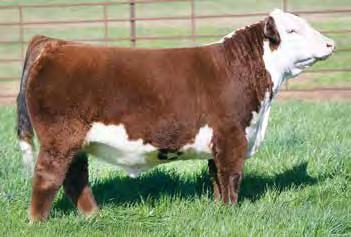
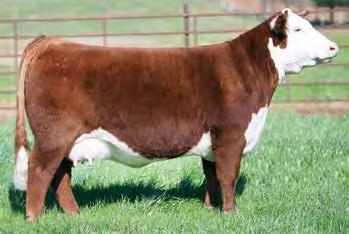

TN
BF WICKED 116K ET 10/4/22 • P44432720 • Polled
SIRE: H Swanson 902 ET
DAM: BF Sinful 8252 ET (UPS Sensation 2296 ET)


CED +5.4 / BW +3.5 / WW +64 / YW +108 / MILK +35 REA +.65 / MARB +.08 / CHB +127
BF MOXIE 120K ET 10/10/22 • P44432722 • Polled
SIRE: H Swanson 902 ET
DAM: BF Girl Power 646 ET (Winchester Powerball)
CED +5.7 / BW +2.5 / WW +62 / YW +106 / MILK +31
REA +.56 / MARB +.05 / CHB +126
BF MEGHAN 205K ET
9/27/22 • P44435102 • Polled
SIRE: KLD RW Marksman D87 ET
DAM: BF Girl Power 646 ET (Winchester Powerball)
CED +4.1 / BW +3.1 / WW +59 / YW +95 / MILK +29 REA +.54 / MARB +.04 / CHB +118
BF AMBITION 11J ET
4/8/21 • P44275353 • Polled


SIRE: Boyd 31Z Blueprint 6153
DAM: BF Novel 5502 ET (Golden Oak Outcross 18U)
Featured in the 2021 Burns Farms and Friends Sale, commanding $20,000 to the Musser Family in Indiana. Two full sib heifer calves sell as well as a full sister with a fall calf at side.
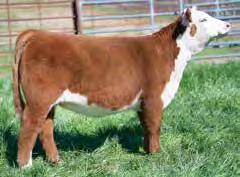

BF SAVAGE SON 4K ET
4/16/22 • P44384555 • Homozygous Polled
SIRE: KLD RW Marksman D87 ET
DAM: BF Girl Power 646 ET (Winchester Powerball)
CED +8.0 / BW +2.4 / WW +61 / YW +99 / MILK +32
REA +.49 / MARB +.14 / CHB +126
Feature of our 2023 Cattlemen’s Congress Grand Champion Pen of 5!
Please contact the farm or the sale manager to request a sale catalog. Catalog & videos online at burnsfarms.com.
Since 1952
DAVID BURNS (615) 477-5668 E-mail: burnsda2@gmail.com
Zach Day, Herdsman (859) 588- 6271
laytond@yahoo.com
laytonauction.com
Pikeville, Tennessee burnsfarms.com Dustin N. Layton • (405) 464-2455
Chisolm Kinder • (405) 747-4683
TAL #6690 TFL #5818
Pork Exports Robust in January; Slow Start for Beef Exports
U.S. pork exports, which posted a strong nish in 2022, maintained momentum in January, according to data released by USDA and compiled by the U.S. Meat Export Federation (USMEF). U.S. beef exports were recordbreaking in 2022 but slowed late in the year. is trend continued in January, as shipments were well below the large totals from a year ago.
Record-large shipments to Mexico lead strong month for pork exports
January pork exports totaled 236,767 metric tons (mt), up 13% year-over-year, while export value climbed 16% to $643.4 million. Exports to Mexico, which nished 2022 on a remarkable run on the way to an annual record, set another volume record in January. Exports also trended signi cantly higher year-over-year to China/Hong Kong, Japan, Canada, the Dominican Republic, Colombia, Honduras and the ASEAN region.
“While Mexico is certainly the pacesetter for U.S. pork exports, it’s encouraging to see such broad-based growth,” said USMEF President and CEO Dan Halstrom. “Market diversi cation is always a point of emphasis for the U.S. industry, and it’s more important than ever to nd new opportunities for U.S. pork in both established and emerging markets.”
Challenging month for beef exports, but bright spots

emerge

Beef exports declined to several major destinations in January, though shipments increased sharply to Mexico, the Dominican Republic, the Philippines and Africa. January volume fell 15% year-over-year to 100,942 mt, valued at $702.3 million (down 32%).
Beef inventories swelled in some key markets near the end of last year, contributing to a challenging environment for U.S. exports.
“While beef exports are o to a slow start in 2023, we remain optimistic that post-COVID foodservice demand will strengthen in additional markets as the year progresses,” Halstrom said.
Lamb exports open 2023 on high note

January exports of U.S. lamb muscle cuts totaled 222 mt, up 161% from the low year-ago volume, while export value essentially doubled to $1.1 million (up 99%). Growth was led by strong increases to Mexico and the Caribbean, while shipments were also higher to Canada and Guatemala.
A detailed summary of the January export results for U.S. beef, pork and lamb, including market-speci c highlights, is available from the USMEF website.

For questions, please email Joe Schuele or call 303-5470030.

50 • Cow Country • April
BULLS: 2yr, Fall & Spring Cow/Calf Pairs Fall Bred Females Open Heifers CONSIGNMENTS FROM: NY, OH, PA & WV LIVE BROADCAST & ONLINE BIDDING View Catalog online at : theovla.com Auctioneer COL L JOOHN N SPPIKKEER R For Catalog or Information Sale Manager JO O E P PR YOR R 740-516-1675 pryorlimousin@yahoo.com Ohio Valley Limousin Association
Count on Y-TEX ® insecticide ear tags to knock out flies, ticks and lice.




Insect pests can wreak havoc on your cattle, from reducing weight gains to carrying costly diseases like pink eye. That’s why it pays to protect your herd with the proven performance of Y-TEX® insecticide ear tags. Y-TEX® tags control a wide range of livestock pests, including horn flies, face flies, stable flies, black flies, Gulf Coast and spinose ear ticks and lice.

So when it’s time to protect your cattle from flies, ticks and lice, look for the insecticide tags that put a stop to profit-robbing pests: TRI-ZAP ™ , MAX 40 ™ , XP 820 ® , OPtimizer ®, PYthon® II, and PYthon® II Magnum™from Y-TEX®





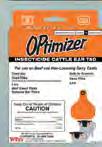


April • Cow Country • 51
read and follow label directions. All brands shown are trademarks or registered trademarks of Y-TEX® Corporation. © 2020 Y-TEX®
Always
Corporation.
Where do you think the phrase
“dropping like flies” came from?
USDA Proposes New Requirements for the “Product of USA” Label Claim
WASHINGTON, March 6, 2023 – e U.S. Department of Agriculture (USDA) today released a proposed rule with new regulatory requirements to better align the voluntary “Product of USA” label claim with consumer understanding of what the claim means. e proposed rule allows the voluntary “Product of USA” or “Made in the USA” label claim to be used on meat, poultry and egg products only when they are derived from animals born, raised, slaughtered and processed in the United States. Today’s announcement delivers on one of the key actions in President Biden’s Executive Order on Promoting Competition in the American Economy, and a commitment made in the Biden-Harris Administration’s Action Plan for a Fairer, More Competitive, and More Resilient Meat and Poultry Supply Chain. e increased clarity and transparency provided by this proposed change would prevent consumer confusion and help ensure that consumers understand where their food comes from.
“American consumers expect that when they buy a meat product at the grocery store, the claims they see on the label mean what they say,” said Agriculture Secretary Tom Vilsack. “ ese proposed changes are intended to provide consumers with accurate information to make informed purchasing decisions. Our action today a rms USDA’s commitment to ensuring accurate and truthful product labeling.”
USDA’s proposed rulemaking is supported by petitions, thousands of comments from stakeholders, and data. In July 2021, USDA initiated a comprehensive review to understand what the “Product of USA” claim means to consumers and inform planned rulemaking to de ne the requirements for making such a claim. As part of its review, USDA commissioned a nationwide consumer survey. e survey revealed that the current “Product of USA” labeling claim is misleading to a majority of consumers surveyed, with a signi cant portion believing the claim means that the product was made from animals born, raised, slaughtered and processed in the United States.
USDA’s comprehensive review shows there is a clear need to revise the current “Product of USA” label claim so that it more accurately conveys U.S. origin information.
Under the proposed rule, the “Product of USA” label claim would continue to be voluntary. It would also remain eligible for generic label approval, meaning it would not need to be pre-approved by USDA’s Food
Safety and Inspection Service (FSIS) before it could be used on regulated product, but would require supporting documentation to be on le for agency inspection personnel to verify. e rulemaking also proposes to allow other voluntary U.S. origin claims we see on meat, poultry and egg products sold in the marketplace. ese claims would need to include a description on the package of all preparation and processing steps that occurred in the United States upon which the claim is made.
USDA encourages stakeholders, both domestic and international, to comment on the proposed rule. e proposed rule will be open for public comment for 60 days a er publishing in the Federal Register. Public comments can be submitted at www.
regulations.gov.
USDA touches the lives of all Americans each day in so many positive ways. In the BidenHarris Administration, USDA is transforming America’s food system with a greater focus on more resilient local and regional food production, fairer markets for all producers, ensuring access to safe, healthy, and nutritious food in all communities, building new markets and streams of income for farmers and producers using climate smart food and forestry practices, making historic investments in infrastructure and clean energy capabilities in rural America, and committing to equity across the Department by removing systemic barriers and building a workforce more representative of America. To learn more, visit www.usda.gov.
Ministers Bibeau and Ng Respond to Changes Proposed to “Product of USA ” Labelling Regulations
Canada’s Minister of Agriculture and Agri-Food, the Honourable Marie-Claude Bibeau, and Minister of International Trade, Export Promotion, Small Business and Economic Development, the Honourable Mary Ng, today released the following joint statement in response to the advance notice of changes that will be formally proposed by the United States to the “Product of USA” voluntary labelling regulations for meat, poultry and egg products.
“ e Canada and United States meat and livestock sectors are highly integrated. is collaboration contributes to the growth and resilience of farmers and processors on both sides of the border. It also allows us to ensure a reliable supply of high-quality products.
“Canada remains concerned about any measures that may cause disruptions to the integrated North American livestock supply chains.
“Canada will closely review the proposed amendments to the labelling of meat, poultry and egg products in the U.S. and will participate in the U.S. rule-making process to ensure that these changes conform to the U.S.’ international trade obligations and do not disrupt supply chains.
“Canada will also rmly oppose any proposition from the United States to renew a mandatory country of origin labelling system for pork and beef, a practice which the World Trade Organization allowed Canada to take retaliation measures against the United States.
“Canada will work with the U.S. to ensure that new de nitions and rules allow farmers, processors and consumers in both countries to continue to bene t from e cient, stable and competitive markets.”
52 • Cow Country • April


















SoKY Select Gelbvieh Sale SATURDAY, APRIL 22, 2023 • 1:00 PM CT United Producers • Bowling Green, KY Young cow/calf pairs like this one sell! Bred heifers like this one sell! Purebred Gelbvieh bulls like this one sell! Balancer bulls like this one sell! Sale managed by Slaughter Sale Management For catalog or information contact: David Slaughter Phone: (270) 556-4259 E-mail: hmslghtr@aol.com Like us on Facebook at Slaughter Sale Management Selling 40 Gelbvieh & Balancer® Females Selling 10 Gelbvieh & Balancer® Bulls
Congratulations to Rockcastle County Beef Association on being the lucky winners of this year’s squeeze chute sponsored by Priefert! The squeeze chute winner was drawn at random following this year’s KCA Convention & Ag Industry Trade Show. To be eligible, County Chapters had to retain 50% or more memberships based on the previous year’s ending membership total by January 1st.
If you need anything for membership, please contact Rachel Cain at (859) 278-0899 or rcain@kycattle.org

54 • Cow Country • April DIVISION 1 (151+ MEMBERS) 20232022Diff Hart 23120328 Shelby 335322 13 Henry 166160 6 Mercer 181179 2 Madison 2752750 Northern Kentucky 161161 0 Larue 154166-12 Washington 207220 -13 Green 141154-13 Hardin 143157-14 Bath 292 318 -26 Bracken 168194 -26 Jessamine 158184 -26 Grayson 223250-27 Edmonson 174 202-28 Marion 277309-32 Breckinridge 246281-35 Casey 146187 -41 Barren 446488-42 Warren 146192 -46 Logan 163 210 -47 Adair 295343-48 Clark 163217 -54 Christian 265320-55 Lincoln 202265-63 Harrison 87 155 -68 DIVISION 2 (76-150 MEMBERS) 20232022Diff Pulaski 141 119 22 Metcalfe 141148 -7 Laurel 136134 2 Meade 136141 -5 Franklin 125132 -7 Monroe 120132-12 Fleming 119 123 -4 Allen 110 135 -25 Scott 109108 1 Daviess 109 119 -10 Jackson 102 91 11 Garrard 100 101 -1 Caldwell/Lyon 98 101 -3 Anderson 96 107 -11 Northeast Area 93 114 -21 Trimble 92 101 -9 Mountain 90891 Trigg 9091-1 Bourbon 8993-4 Boyle 8898 -10 Pendleton 8488-4 Fayette 81810 Louisville Area 7277-5 Owen 6996-27 Purchase Area 6785 -18 Webster 6577 -12 Clinton-Cumberland5780-23 Twin Lakes 5683-27 DIVISION 3 (UP TO 75 MEMBERS) 20222021Diff Muhlenberg 7175-4 Lewis 70673 Grant 67589 Robertson 6573-8 Russell 6273 -11 Out of State 6271-9 Nelson 62557 Campbell 6162-1 Woodford 6163-2 Rockcastle 5570 -15 Mason 5566 -11 Taylor 5464 -10 Oldham 5058-8 Estill 48453 Whitley 47434 Montgomery 47470 Todd 4546-1 Ohio 4446-2 Calloway 3975-36 Wayne 3844-6 Simpson 38371 Nicholas 3641-5 Carroll 36351 McCreary 35296 Hancock 3541-6 Highlands 3145 -14 Union 3139-8 Butler 3031-1 Knox 28253 Bullitt 2728-1 Clay 2231-9 Crittenden 2125-4 McLean 2023-3 Hopkins 2024-4 Menifee 1819 -1 Livingston 17 20-3 Henderson 9 13 -4 Gallatin 871 Eastern Foothills651 Magoffin 56-1 Powell 56-1 Pike 34-1 Harlan 110 Bell 02-2
2023 2022Difference Totals as of: March 13, 2023 9,76510,920-1,155
2022-23 MEMBERSHIP APPLICATION
* MEMBERSHIP YEAR 10/1/22– 9/30/23
*Payments of KCA membership dues are tax deductible for most members as an ordinary and necessary business expense. However, charitable contributions of gifts to KCA are not tax deductible for Federal Income Tax purposes. Due to new IRS regulations, $2.24 of your dues would not be deductible. Approximately $12 of your dues will go towards the monthly publication Cow Country.
PLEASE CHECK THE MEMBERSHIP(S) YOU WOULD LIKE TO JOIN:
KCA MEMBERSHIP ($30/YR) NEW RENEWAL
Membership dues are $30 unless otherwise listed below
KCA COUPLE MEMBERSHIP
To add your spouse, please add $15 to your KCA Membership
KENTUCKY JUNIOR CATTLEMEN’S ASSOCIATION ($10/YR) NEW RENEWAL





I WOULD LIKE ADDITIONAL INFORMATION ON THE YOUNG PRODUCER’S COUNCIL
TOTAL MEMBERSHIP:
$ KCA $ KJCA
TOTAL CONTRIBUTIONS:
$ CATTLEMEN’S FOUNDATION DONATION (voluntary)
TOTAL AMOUNT ENCLOSED:
$ ALL DONATIONS TO KCF ARE TAX DEDUCTIBLE
COUNTY DUES
Dues are $30 except for the counties listed below.
Allen...............................$40
Anderson........................$25
Bourbon.........................$20
Boyle ..............................$35
Bullitt..............................$20
Butler..............................$25
Franklin ..........................$25
Highlands .......................$20
(Boyd, Floyd, Johnson, Lawrence, & Martin)
Hopkins ..........................$35
Laurel.............................$35
Lincoln ...........................$25
Louisville Area ................$20
(Jefferson, & Spencer)
Magoffin .........................$20
Menifee ..........................$25
Mountain........................$25
(Breathitt, Knott, Lee, Leslie, Letcher, Morgan, Owsley, Perry & Wolfe)
Oldham ..........................$35
Taylor..............................$20
Twin Lakes ......................$20
Warren ...........................$40
Wayne ............................$25
Whitley ...........................$25
Woodford......................$25
April • Cow Country • 55
NAME SPOUSE NAME FARM NAME ADDRESS CITY COUNTY STATE ZIP RECRUITED BY PHONE FAX EMAIL
1-100
YOU WOULD ALSO LIKE TO JOIN THE NATIONAL CATTLEMEN’S BEEF ASSOCIATION
NCBA is now a State Marketing Partner with the KCA. You can pay your dues to both organizations with one check, at the same time. # HEAD DUES $150 101-250$300 251-500$450 501-750$650 751-1000$650 1,001-1,250$1,150 1,251-1,500$1,400 1,501-1,750$1,650 1,751-2,000$1,900 > 2,000$1,900
# HEAD DUES Complete and return to: Kentucky Cattlemen’s Association 176 Pasadena Drive • Suite 4 • Lexington, KY 40503 Join online at www.kycattle.org or call (859) 278-0899 April • Cow Country • 55
IF
The
+ .38/HD
Kylie Trail Director of Brand Management

BEEF ITS WHAT'S FOR DINNER 300 Tomahawks, It’s What’s for Winners at Daytona!

In February, I had the opportunity to take Checko Committee Members: Kent Robertson, Don Pemberton, and Allison Nissley to spend the weekend volunteering at Daytona International Speedway for the Beef. It’s What’s For Dinner 300 X nity Race!

is consumer outreach promotion is led by the National Cattlemen's Beef Association, a contractor of the Beef Checko , with immense support from multiple participating State Beef Councils. Austin Hill was the back-to-back winner of the 2023 Beef. It’s What’s For Dinner.® 300, the 42nd annual NASCAR X nity Series season opening race, one day before the iconic DAYTONA 500. For the second year in a row, Austin Hill drove into victory lane where he was greeted by a buckle and a Tomahawk Steak to close out a week that showcased all things beef and agriculture to race fans young and old.
Along with the race sponsorship, we also had a booth in the fan experience zone that was a huge hit. ere were long lines all day to spin the beef cuts wheel for a prize, sample brisket sliders, and learn to rope a calf! ese were great ways to get fans excited about trying new cuts of beef and interacting with farmers and ranchers to increase their trust in our product. Another piece to the activation was highlighting fans on the in eld that were grilling beef by handing out signs that read “Grilling Beef Here”, that were proudly displayed at nearly every camp sight.
For race fans not able to join the tailgate in person, a satellite media tour took the tailgate to them. Just two days before the race, award winning chef Ryan Clark, Tucson’s Iron Chef for three consecutive years and Executive Chef for the AAA 4-Diamond and Forbes 4-Star Hotel Casino Del Sol, was live from the track for interviews with TV and radio stations across the country. Chef Clark shared two of his favorite race day recipes – a Beef, Beer & Cheese Dip and BBQ Beef Sliders – both perfect for tailgating, or homegating.
Finally, the Beef. It’s What’s For Dinner. brand was also showcased nationwide through various advertising e orts before and during the race. In addition to signage on the racetrack, funding from several State Beef Councils allowed for commercials showcasing beef to a national audience on FS1 during the race. Ads were also featured on various digital platforms and billboards could be seen in the Daytona International Airport and along the highway approaching the speedway.
A er attending the event in person each one of the committee members that attended agreed that this national promotion was time and money well spent and was e ective in increasing the demand for beef!
OWENSBORO BURGER WEEK
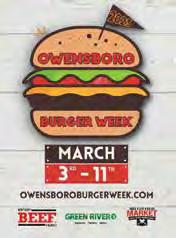
is year was the third year now that KBC has been the presenting sponsor of the Owensboro Burger Week. is event continues to grow and exceed all expectations, the excitement and participation around this event is electric. is year 38 restaurants participated in the 9-day promotion where their chefs cra ed a signature burger to be sold for $7 dollars. It was such a hit many locations had trouble keeping up with the demand for these specialty burgers.
During my time in Owensboro, we had the opportunity to get area cattlemen immersed into this checko -funded promotion by hosting a Cattlemen’s Pop-up Event held at e Miller House. is was a chance for cattlemen to catch up with what their Beef Checko is doing in their own county to increase beef demand while enjoying a signature burger!
THE RESULTS ARE IN!
The Owensboro Burger Week promotion produced record sales for Daviess County restaurants. There were over 34,549 specialty burgers sold for $7 a piece at 38 participating restaurants. Over $241,843 was spent in nine days on featured burger sales alone. That's a lot of beef consumed!
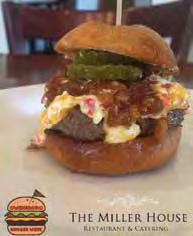

56 • Cow Country • April
As we transition into Spring time, most people seem to begin looking forward to warmer weather, longer days, and ring up their grills. I look forward to those things for sure, but there are also a lot of opportunities to get more involved with our educators across the state. Some of those ways have been through eld trips, agriculture day events, however one of the ways that has been bene cial is through our beef demonstrations.







What I have been able to nd is that the majority of our high school students are somewhat familiar with the kitchen, however the idea of correctly purchasing and cooking beef is intimidating to them. e opportunity to make educated consumers who will continue to consume and purchase beef starts while they are in high school. Also, most of the students who attend these events do not come from cattle farming backgrounds. In my opinion, we have an obligation as members of the beef industry to help students make connections between the beef farmer story, all the way to beef consumption tips and tricks. When presenting during these demonstrations, I really work to engage with students and answer the questions that they have regarding various cuts of beef, cooking methods, and beef advocacy. Reaching almost 300 students, Morgynne Lunsford and I have visited schools all across the state including Ms.Hunter-Anne Julian’s Food Science and Animal Science classes at South Warren High School, Mrs. Darilyn Hamilton and Mrs. Kaitlin Eades Animal Science and Principles of Agriculture classes at Spencer County High School, and Mr. Conner Richardson’s Principles of Agriculture classes at Woodford County High School. If you are interested in learning more about how to have a beef demonstration in your classroom, contact Bradon at bburks@ kycattle.org.
We would also like to o cially announce the Kentucky Beef Council’s Advocacy Summit and Youth Advocacy Summit for this year as well. During these events, attendees will be able to take a deeper dive of how to share their beef message with both producers and consumers. With the help of NCBA’s Director of Grassroots Advocacy and Spokesperson Development, Mr. Chandler Mulvaney, we know that these events will be bene cial for attendees on all age levels and knowledge levels. Our Adult Summit will be April 28th and our Youth Summit will be on April 29th, both at e YARDS Classroom at Blue Grass Stockyards in Lexington, KY. For more information or to register for either event, visit www.kybeef.com.


April • Cow Country • 57
Bradon Burks Director of Education
University of Kentucky Extension and Kentucky Beef Network Offer Free


BQCA Certi cations in April and September
e Kentucky Beef Network and University of Kentucky Extension are pleased to announce that they will be o ering free Beef Quality and Care Assurance (BQCA) certi cations in April 2023 and September 2023.


e Kentucky BQCA program takes national BQA practices one step further to provide a holistic program for Kentucky producers, by adding cattle handling and animal care component to the training modules. Educational modules provide the best management practices for handling cattle and providing for their well-being, in addition to training on the core principles of BQA.
e cost of BQCA enrollment is $5 for in person training through their local county extension o ce and $10 for online training, however from April 1- 30, 2023 and September 1-30, 2023 the Kentucky Beef Network and University of Kentucky Extension will be sponsoring the enrollment costs, making it free for producers.
Producers interested in taking advantage of this opportunity can visit www.kybeefnetwork.com to access the online training platform or contact their county extension o ce for training opportunities.
“We are very excited for this partnership for our Kentucky cattlemen to continue to tell their story to consumers through sound management practices,” says Kevin Laurent University of Kentucky CoBQCA Coordinator.
e Kentucky Beef Network and University of Kentucky merged their Cattle Handling and Care Program with the National BQA program to create a new program, aptly named the Beef Quality and Care Assurance (BQCA) program. is program was implemented to raise awareness of practices that ensure the proper handling and welfare of cattle while keeping farmers safe and continuing to supply healthy beef to consumers. In turn, this program enables beef and dairy producers to enhance their product, maximize marketability and strengthen consumer con dence.

58 • Cow Country • April BEEF QUALITY ASSURANCE CHUTE SIDE TRAINING THURSDAY • APRIL 20 Blue Grass Stockyards - Lexington 4561 Ironworks Pike • Lexington KY 40511 VACCINE HANDLING CATTLE HANDLING BODY CONDITION SCORING HAY & FORAGE QUALITY CHANGES IN ANTIBIOTIC & IMPLANT USE Pre-register
April 17
the Kentucky Cattlemen’s Association office at (859) 278-0899 or email kbn@kycattle.org REGISTER SOON! 60 spots available!
SAVE THE DATE
by
by calling
Attendees who complete the BQCA exam at the end of the training will become
BQCA Certified. BQCA certification is valid for three years.
Eden Shale Update
Dan Miller Industry Coordinator, Kentucky Beef Network


March at Eden Shale means calving season. is year has been warmer and drier than normal which makes things nice. It makes you realize why producers enjoy fall calving with no mud.

If you recall, last spring we bred 114 females. As of this spring we have 97 bred cows that are expected to calve. at equates to a an 85% total conception across the entire herd.
e herd is broken into two main groups during calving season. e mature cow herd consists of cows that are having at least their third calf. is year we have 63 of these mature cows. ey will mainly calve out in the pasture and Greg will ear tag them and rotate them to new pasture as they calve.

e second group is made up of rst and second calf heifers and they will calve at the barn next to Greg’s house. is makes keeping a close eye on them much easier. is year we have 34 heifers at this facility to calve.
Much like the cows, as the heifers calve the babies will get tagged and the pair will get moved into the “nursery” eld for the next 10-12 days. Once the babies are stronger and doing good, those pairs will get moved in to a third eld. is rotation during calving season makes it easy to locate new calves because we are always moving them out of the pregnant group and into the nursery. e nursery group never has large numbers in it as we are always adding to it but also moving the older stronger calves out. e last group starts small and continually has new pairs added to it until calving season is over. is rotation allows us to keep the mud at a minimum and have fresh pasture that we are rotating the new calves to which keeps the udders cleaner and the calves healthier.
As of writing we have had 52 calves born in the rst 18 days of the calving season. at is 54% of the calf crop born in two and half weeks! In my opinion this is the best reason to synchronize and AI the herd. Having the calves all be similar in age and size makes it easier to manage them throughout their time at the farm. e AI component gives us consistent genetics and coloration throughout the calf crop and it allows an advantage at marketing when there are more animals that will sort onto the same load.
On the farm there are many things that are di cult to control. In my opinion the length of your calving season is the easiest thing to manage. Besides; calving season is hard, so why allow it to drag on for months…


April • Cow Country • 59 Ben Lloyd Whitesville, KY (270) 993-1074 benlloyd0223@gmail.com Charles Embry Cave City, KY (270) 646-5939 dale.embry@yahoo.com Jacob Settles Springfield, KY (859) 805-0724 jacob.settles4@yahoo.com Ron Shrout Winchester, KY (606) 205-6143 ronshrout@bellsouth.net Jeff Stephens Ewing, KY (606) 782-7640 stephensbeef@gmail.com KENTUCKY BEEF NETWORK FACILITATORS
BOYD BEEF CATTLE
6077 Helena Road
Mayslick, KY 41055
Charlie Boyd II: (606) 584-5194 • Blake Boyd: (606) 375-3718 www.boydbeef.com • cboyd2@maysvilleky.net

ANGUS
THE BUSINESS BREED
HILL VIEW FARMS
Jimmy Gilles 5160 Lee Rudy Road Owensboro, KY 42301 (270) 929-5370 jcgilles86@gmail.com
BRANCH VIEW ANGUS
927 Old Liberty Pike • Hustonville, KY 40437 (859) 238-0771 • www.branchviewangus.com
James S. & LuAnn Coffey, Donald & Donna Coffey Annual Production Sale- 2nd Saturday in April


BURKS CATTLE CO.



531 Rick Rd. Park City, KY 42160
Eddie Burks • (270) 991-6398 www.burkscattle.com
BURTON & SONS ANGUS

Joe D. or Karen Burton
480 Hominy Hill Rd. Nancy, KY 42544
Joe: (606) 305-3081
Located 15 miles West of Somerset • klburton01@windstream.net

Bulls & females sold private treaty. Inquiries Welcome. Sell only what we would buy. Data driven since 1981.
COFFEY ANGUS FARMS
661 Hopewell Road Liberty, KY 42539
Matt Coffey: (270) 799-6288
Dewey Coffey: (606) 706-2699
Genetics for Maximum Profitability since 1984
DAVIS BEND FARMS

2315 Davis Bend Road Canmer, KY 42722 timmothyljeffries@gmail.com www.davisbendfarms.com
Tim: (270) 528-6605 • Leslie: (270) 528-6435
FALL CREEK ANGUS
448 Corder Farm Road Monticello, KY 42633

Ronnie Corder (606) 348-6588
HAMILTON ANGUS FARMS
Eddie Hamilton 2142 Stilesville Road Science Hill, KY 42553 edjohami@aol.com
(606) 271-1286
Bulls and Females for Sale
President: Henry B. Smith
Vice President: Anne Patton Schubert
Secretary/Treasurer: Shayna Gibson
PLEASANT HILL FARMS

Gil, Mary, Corbin, Caroline, and Catherine Cowles
500 Rockfield Richpond Road
Rockfield, KY 42274
(270) 843-9021 • Fax (270) 843-9005
Located 7 miles west of Bowling Green, 1/2 mile off Hwy 68/80
HERITAGE FARM
Tom McGinnis
1024 Hinkle Lane • Shelbyville, KY (502) 633-1634, home • (502) 633-5100, work (502) 655-0164, cell
JOHNSON FARMS ANGUS
Angus Bulls & Females Slaughters, KY
Keith: (270) 635-0723
Reese: (270) 635-1137
LYNN CREEK FARMS
Kris and Sara Lynn 2184 Bardstown Rd Springfield KY 40069 573-721-6663
MT. MORIAH ANGUS FARMS
Bob, Kathy, Rob, and Janna Clark (859) 748-5558 1446 Kennedy Bridge Rd. Harrodsburg, KY 40330 Bob: (859)339-2610 • Rob: (859)612-1594 mtmoriahfarms1@gmail.com www.mtmoriahangus.com
FOUR KINGS ANGUS
250 Bright Leaf Dr. • Harrodsburg, KY 40330 Cary & Kim King Carymking@yahoo.com • fourkingsangus.com
Cary Cell: (859) 613-3734 • Colby Myers - Purebred Manager
SMITHLAND ANGUS FARM

5202 East Hwy 80, Russell Springs, KY 42642
Charles “Bud” & Pam Smith: (270) 866-3898
Henry & Melissa Smith: (270) 866-2311


ST. CLAIR FARMS REGISTERED ANGUS
Eric & Sherry St. Clair
13433 Falls of Rough Road • Falls of Rough, KY 40119
Home: (270) 257-2965 • Cell: (270) 617-1079
www.stclairangus.com
Performance Tested Bull & Female Sale April 2020
TAMME VALLEY FARM

Jacob Tamme, Owner-Operator (859) 583-7134 jacob.tamme@gmail.com www.tammevalley.com & Find us on Facebook!
TRIPLE D ANGUS
Nathaniel & Darla Denham
Nathaniel(Bub), Sarah, Ashley Denham (606) 423-2457 • (606) 875-0780 tripledangus.com
WHITE FARM
OLD BARK FARM
370 Ferrill Hill, Buffalo, KY 42716 Kenley Conner (502) 905-7825 Registered Angus Cattle
4040 Taylorsville Rd Taylorsville, KY 40071
Gordon Schubert
502-477-2637 • 502-548-8440
Anne Patton Schubert
502-477-2663 • 502-548-2359
Tim and Amy White 3664 Military Pike • Lexington, KY 40513 Home: (859)223-0326
Tim: (859) 509-5401 • Amy (859)227-2552 whitefarm4@twc.com
KENTUCKY ANGUS ASSOCIATION MEMBERSHIP APPLICATION

Return to: Shayna Gibson 1220 Angus Trail Lexington, Kentucky 40509 • Annual Dues $35

60 • Cow Country • April
NAME FARM NAME ADDRESS CITY STATE ZIP PHONE 1 PHONE 2 EMAIL
Shayna Gibson named new KY Angus Association Secretary/Treasurer
Shayna graduated from the University of Kentucky with a Bachelors degree in Community and Leadership Development in 2015. She is the District Administrative Secretary for the Henry County Conservation District going on 6 years. She is happily married to her high school sweetheart, Dallas Gibson since 2017. He is a lineman at Shelby Energy Cooperative in Shelby County, Kentucky. They welcomed a little girl; Paisley Lane Gibson in November of 2021 and they couldn’t imagine life without her. They recently purchased the family farm that Shayna grew up on. Dallas and Shayna are running a Registered Angus cow/calf operation known as Circle G Angus in New Castle, Kentucky.
Shayna grew up as an avid 4-H and FFA member where she showed Registered Angus cattle. Shayna was the

Henry County FFA Chapter President as well as the Northern Kentucky Region FFA Treasurer. She received her Chapter, State and American FFA degree. She was a Regional Director for the Kentucky Junior Cattlemens Association. She was a member of the National and Kentucky Junior Angus Association. Shayna had the opportunity to attend LEAD Conferences through the National Junior Angus Association where she met several great people that she still keeps up with to this day.
Once Shayna graduated from the University of Kentucky, she came home and started the Henry County 4-H Livestock Club where she was the advisor for 6 years. Shayna is very active in her community where she is a member of the Henry County and
Kentucky Cattlemens Association and has served on several boards such as the Kentucky Association of Conservation District Employees Association, Ag Development Council, Henry County Youth Livestock Auction Committee, and the Henry County 4-H Council.
Shayna is very excited to start her new role as the Kentucky Angus Association Secretary/Treasurer. She knows she has large shoes to fill as Anne is leaving after 17 years of hard work and dedication to the KAA. If you have any questions for Shayna, please feel free to reach out to her. It is such on honor to be serving on the Kentucky Angus Association board.
April • Cow Country • 61 KENTUCKY ANGUS ASSOCIATION NEWS
www.kentuckyangus.org • kyangusassociation@gmail.com • @kyangusassoc • @kyangusassoc • @kyangusassociation
Anne Stewart DeMott, Secretary/Treasurer
Kentucky Hereford Association


2023 Membership Dues: KHA $25 and KJHA $10
If you haven’t paid your dues, please do so by April 10th. Contact Suzanne Matheny for information. 606.584.0577
WELLS FARM
Toby & Debby Dulworth 2492 S. Kirkman Road LaCenter, KY 42056 (270) 224-2993
dogwood@brtc.net
Herefords that thrive on forages. www.dogwoodherefords.com
6077 Helena Road
Mayslick, KY 41055
Charlie Boyd II
606-584-5194
Annual Bull Sale second Saturday in March
Hereford and Angus Bulls
Chambliss
Hereford Farms
Brad, Carla, Clay & Clint Chambliss 1101 Driftwood Lane
Elizabethtown, KY 42701
Home (270) 982-3905
Cell (270) 668-7126 fax 270-735-9922
www.chamblissherefordfarms.com
WCN Polled Herefords
Since 1961
Bill Norris
2220 Celina Road
Burkesville, KY 42717
Phone (270) 433-7256
Cell (270) 433-1525
“Every calf needs a white face”
NJB Limited

Polled Herefords 439 Flatwoods Frozen Camp Rd, Corbin KY 40701 Bobby & Brenda Wells (606) 523-0569 or (606) 344-0417 wells_farm@yahoo.com
Kevin, Angela, Kenlea & Kyler Murray (606) 528-1691 or (606) 682-8413
MPH Farms
Registered Polled Herefords PAUL L. HANCOCK 8559 KY 56 Owensboro, KY 42301 270-771-4194
Jackson Farms
Registered Polled Herefords PO Box 215 Cross Plains, TN 37049 615-478-4483 billymjackson@aol.com
“Farming the Same Land Since 1834”
WOLF FARM
Registered Polled Herefords
Bulls & Females for sale
Tim & Peggy Wolf
12939 Peach Grove Road
Alexandria, KY 41001
Home: 859-635-0899
Cell: 859-991-3484
KHA OFFICERS
President: L.W. Beckley
Secretary/ Treasurer: Suzanne Matheny 606-584-0577 suzannebmatheny@gmail.com
K3 CATTLE REGISTERED HEREFORDS
KYLE BUSH
K3CATTLE@YAHOO.COM
859-588-4531
198 HICKS PIKE CYNTHIANA, KY 41031
THOMAS FARM
Eric & Ronnie Thomas 2396 Union City Rd. Richmond, KY 40475
(859) 623-5734
Eric’s Cell (859) 314-8256
“Cattle for sale at all times”
Dale Stith 5239 Old Sardis Pike Mays Lick, KY 41055
dalestith@yahoo.com
(918) 760-1550
Home of Select Sires’ Boyd
Fort Knox 17yxz54040

Polled Hereford and Gelbvieh Cattle 3459 KY Hwy. 1284 E. Cythiana, KY 41031 (859) 234-6956
Ben, Jane, Shelby and Lincoln
Windy Hills Farm
Jackie D. Perkins II 367 Mt. Pisgah Rd. Bremen, KY 42325
(270) 543-3586
Breeding to produce good cows since 1981
HEREFORDS
Codee Guffey • 1815 Grassy Springs Road
Versailles, Kentucky 40383 (502) 598-6355
rockridgeherefords@gmail.com
www.rockridgeherefords.com

TK4 Herefords
Tony & Kathy Staples 992 Knotts Road Brandenburg, KY 40108 (270) 422-4220 tstaples@bbtel.com

PILE STOCK FARM
Registered Polled Herefords
HANSELL PILE, JR. 12045 St. John Rd. Cecilia, KY 42724
270-735-5192
270-862-4462
12 miles West of Elizabethtown
T S F
Peyton’s Well Polled Herefords
The Lowell Atwood Family 133 Edgewood Drive • Stanford, KY (606) 365-2520 home/fax





(606) 669-1455 cell
Victor- influenced cattle bred for performance on grass.
“Black cows need a good Hereford Bull”
BECKLEY HEREFORDS
L. Wayne Beckley • 1420 Fitchburg Rd. Ravenna, KY 40472 • 606-723-3021

Cell: 859-779-0962
L.W. Beckley D.V.M 284 Pyrse Lane • Irvine, KY 40336
Cell: 859-779-1419 • Clinic: 606-726-0000
www.beckleyherefords.com
TUCKER STOCK FARMS
“Breeding Polled Herefords for over 58 Years”
Breeding cattle for sale at all times.
1999 Walnut Hill Rd. Lexington, KY 40515 (859) 271-9086
cell (859)533-3790
Danny Miller jmspolledherefords.com
270-465-6984
270-566-2694
Tucker Stock Farms
“Registered Angus and Polled Herefords”
“Registered Angus and Polled Herefords”


John A. Tucker II 1790 Hidden Valley Lane Hudson, KY 40145 (270) 257-8548
John Tucker II 1790 Hidden Valley Lane Hudson, KY 40145 270-617-0301
Office (270) 257-8167
18-month-old Angus & Polled Hereford Bulls
“Bulls always for Sale”
WATSON LAND & CATTLE
Matt, Melinda, Harlee, & Wyatt Watson 6196 Mount Sterling Rd Flemingsburg, Kentucky melindawatson8660@gmail.com
Matt - 606-748-1600
Melinda - 859-625-8660
CATTLE FOR SALE AT ALL TIMES
April • Cow Country • 63
4850 Caldwell Ridge Rd. Knifley, KY 42753 270-465-6984 Fertility Milking Ability Calving Ease Disposition Multi-Trait Selection LINEBRED VICTOR DOMINO CATTLE
Modern-day ranching requires more information to produce better animals. International Genetic Solutions works across breeds to provide more accurate head-to-head comparisons and maximum profitability.

IGS incorporates generations of data and the world’s largest multi-breed database to enable more powerful breeding decisions than ever before.
Better cattle. Better profits.
SIMMENTAL

KEVIN AND RACHEL BARRON
Crestwood, Ky
(502) 905-5851 rkbarron812@gmail.com

SWAIN SELECT SIMMENTAL

12113 Green Valley Dr. Louisville, KY 40243 frederickswain@bellsouth.net facebook.com/swainselectsimmental
Fred & Phyllis: 502-245-3866 502-599-4560
Chi & Angie: 502-287-2116
ROCKING P LIVESTOCK

8308 Orangeburg Road Maysville, KY 41056
Chan: 606-584-7581








Keith: 606-584-5626 rockingplivestock@maysvilleky.net
BRIAN & HEATHER SWAIN 3906 Pottertown Road Murray, KY 42071 • 270-293-4440


wksbswain@murray-ky.net

SIMMENTAL AND SIMANGUS BULLS FOR SALE

1939 Huntertown Road Versailles, KY 40383







BULLS FOR SALE
JUDY AND RONDAL DAWSON
1156 Buzzard Roost Road Shelbyville, KY 40065 502-593-5136 • jrdawson22@outlook.com

Chris Allen 859-351-4486 callenuky@hotmail.com
Dr. Henry Allen 859-229-0755







406.205.3033 • internationalgeneticsolutions.com


STAND TOGETHER
IGS
HEAD TO HEAD
Genetic Solutions IGS
KENTUCKY
to:
1254
Paris, KY 40361 FARM NAME YOUR NAME ADRESS CITY, STATE ZIP WORK PHONE HOME PHONE Call or visit one of these Simmental breeders for cattle that work! www.kysimmental.com Membership Fee is $25.00
International
JOIN
SIMMENTAL ASSOCIATION Mail
Laura Jackson
Cynthiana Road
BILL KAISER • Shelbyville, KY • 502.639.4337
859.707.7200 KENTUCKY BEEF EXPO March 3 - Simmental Show @ 4 PM March 4 - Simmental Sale @ 11 AM
BRET AND LAURA JACKSON 859.533.3718 or
PRIVATE TREATY SALES CHECKOFF INVESTMENT FORM
State and National Beef Promotion and Research Programs Information is required by 7 CRF 1260.201. Failure to report can result in a fine. Information is held confidential per 7 CRF 1260.203.
Total Checkoff Payment for STATE OF ORIGIN*
X BUYER SELLER PHONE
X
Send Report and Remittance to: Kentucky Beef Council
176 Pasadena Drive
Lexington, KY 40503
For additional information: call 859-278-0899 or email beef@kycattle.org
*If the cattle purchased came from another state within the last 30 days, indicate from which state the cattle were purchased.
The U.S. Department of Agriculture (USDA) prohibits discrimination in all its programs and activities on the basis of race, color, national origin, age, disability, and where applicable, sex, marital status, familial status, parental status, religion, sexual orientation, genetic information, political beliefs, reprisal, or because all or part of an individual’s income is derived from any public assistance program. (Not all prohibited bases apply to all programs.) Persons with disabilities who require alternative means for communication of program information (Braille, large print, audiotape, etc.) should contact USDA’s TARGET Center at (202) 720-2600 (voice and TDD). To file a complaint of discrimination, write to USDA, Director, Office of Civil Rights, 1400 Independence Avenue, S.W., Washington, D.C. 20250-9410 or call (800) 795-3272 (voice) or (202) 720-6382 (TDD). USDA is an equal opportunity provider and employer.
April • Cow Country • 65 TODAY’S DATE ID NUMBER (IF KNOWN) SELLER’S NAME CITY SELLER’S SIGNATURE STATE ZIP
BUYER’S NAME ADDRESS ADDRESS CITY STATE ZIP BUYER’S SIGNATURE DATE OF SALE PERSON REMITTING FORM TOTAL NUMBER OF CATTLE SOLD + = $
Both the seller and the buyer are responsible for making sure that the $1 per head assessment is collected and remitted to the Kentucky Beef Council. $ $1.OO per Head Federal Checkoff $ $1.OO per Head State Checkoff Federal and State
According to the Paperwork Reduction Act of 1995, an agency may not conduct or sponsor, and a person is not required to respond to a collection of information unless it displays a valid OMB control number. The valid OMB control number for this information collection is 05810093. The time required to complete this information collection is estimated to average 1 hour per response, including the time for reviewing instructions, searching existing data sources, gathering and maintaining the data needed, and completing and reviewing the collection of information.
MARCH 25South Missouri Bull & Female SaleCarthage, MO
MARCH 25 Candy Meadows Farm The Cowman’s Kind XXVII Lexington, TN
MARCH 25Bluegrass Gelbvieh Alliance Lexington, KY
MARCH 25Stephens Genetic Advantage Bull SaleParis, KY
MARCH 25The Clear Choice Bull Sale Milan, IN

MARCH 27 Oak Hollow Angus 45th Annual First Choice Bull Sale Smiths Grove, KY
MARCH 27Maplecrest Farms Spring Bull SaleHillsboro, OH
MARCH 28GenePlus Sale Concord, AR
MARCH 31KCF Youth Scholarships Applications Due
APRIL 1 10th Annual Commercial Open Heifer Sale London, KY
APRIL 1Angus Opportunity Sale Canmer, KY
APRIL 1 Grassy Valley Angus 30th Annual Production Sale Greeneville, TN
APRIL 1 West Tennessee Association Bull Test Sale Milan, TN
APRIL 1The Andras Kind Red Angus Bull SaleManchester, IL
APRIL 1Circle G Angus Ranch The Female SaleAdel, GA
APRIL 1Belles & Bulls of the BluegrassLexington, KY
APRIL 4 Annual Online Sale Roan for the Roses Spring Edition Online
APRIL 7Ingram Angus Spring Production SalePulaski, TN
APRIL 8Branch View Angus Sale Hustonville, KY72
APRIL 8 Crazy K Ranch The 10th Annual Production Sale Michie, TN
APRIL 8 Knoll Crest Farm’s Spring Bull & Female Sale Red House, VA
APRIL 8 TJB/3T KY Elite Genetics Bull and Female Sale Upton, KY71
APRIL 8 Amburgey Charolais Farm Annual Bull & Female Sale Mt. Sterling, KY30
April 1022nd Annual Grass Time Partners SaleParis, KY40
APRIL
DATEEVENT LOCATION AD
APRIL 15 Central KY Angus Association 57th Annual Spring Sale Danville, KY24
APRIL 15 Clifford Farms & Guests Hereford Production Sale Lexinton, KY
APRIL 15 91st Indiana Beef Evaluation Program Performance Tested Bull Sale IBEP Test Station
APRIL 20
JMar Genetics New Beginnings Charolais Bull & Heifer Sale DVAuctions
APRIL 20Chute Side BQA Training Lexington, KY58
APRIL 21Casey County Cattlemen’s SaleLiberty, KY17
APRIL 22SoKY Select Gelbvieh Sale
Bowlig Green, KY53
APRIL 22Optum Angus Genetics of the FutureSeaman, OH17
APRIL 22GMAA “Looking to the Future”
Campbellsburg, KY 2
APRIL 22Upper Cumberland Angus Female SaleCookeville, TN21
APRIL 22 Middle Tennessee Hereford Association 2023 Spring Sale Cross Plains, TN48
APRIL 29
Barnes Herefords Southern Belles Female Production Sale
MAY 6 30th Annual Pasture Performance
Tested Angus Bull & Female Sale
Cedartown, GA46
Aldie, VA19
MAY 6Heartland Highland Cattle AuctionSpringfield, MO17
MAY 6 Ohio Valley Limousin Association Spring Sale
MAY 7
Mineral Wells, WV50
Bridge View Angus 16th Annual Production Sale Stamping Ground, KY 25
MAY 13Burns Farms Annual Female EventPikeville, TN49
MAY 20West KY Select Bred Heifer SaleGuthrie, KY18
MAY 29
White Hawk Ranch Beefmaker Female Sale Buchanan, GA
JUNE 30KCA Hall of Fame Applications Due 12
SEPT 7CPC Fall Field Day Fountain Run, KY8
OCT 12 JMar Genetics Quality Over Quantity
Charolias Bull Heifer Sale
DVAuctions
OCT 14The Future is Now Fall Production Sale Bowling Green, KY 3
66 • Cow Country • April
SALERS THE BALANCED BREED DIAMOND J SALERS Donald Johnson • 11660 N. Hwy 1247 • Eubank, KY 42564 606-379-1558 WILLIS FARMS Danny Willis • 964 Johnson Rd • Frankfort, KY 40601 • 502-803-5011 drwc21@aol.com DEL-SU FARM Howard & Sue Edwards • 420 Rose Rd • Somerset, KY 42501 606-679-1675 • Jeriah Privett • 606-416-1154
CALENDAR OF EVENTS
11 St. Clair
Annual Bull & Female Sale Falls of Rough, KY 22
AD
Farms
DATEEVENT LOCATION
REGISTERED RED ANGUS BULLS FOR SALE
* FREE DELIVERY *
FOUR WINDS FARM
N ew Castle, Kentucky (502) 296-1044

PERFORMANCE TESTED PUREBRED ANGUS BULLS FOR SALE
Call 270-202-7186 for more info or check out www.oakhollowangus.com for current availability.
POLLED HERFORD BULLS FOR SALE
19-20 month old Polled Hereford bulls. Good selection. Low birthweight, medium frame. Free Delivery Available. JMS Polled Herefords, Knifley, KY Danny 270-566-2694
Trent 270-566-2000
THE FOUNDATION SALE IX
September 16, 2023
United Producers Facility, Bowling Green, KY
Selling FULLBLOOD & PUREBRED LIMOUSIN
Genetics For info call: A C H Holdings, LLC

Stephen Haynes 270-799-8685
REGISTERED BLACK SIMMENTAL BULLS
Many blaze faced. Excellent EPD’s. Semen Tested. Delivery Available. Maximize your profit with proven performance. All bulls qualify for new CAIP cost-share.
Adam Wheatley 502-349-2665

BREEDING AGE HEREFORD BULLS FOR SALE AT ALL TIMES
Over 60 years of Line 1 Hereford Genetics. Groups of open and bred heifers available for sale at all times. Chambliss Hereford Farms. 270-668-7126
RED ANGUS, SIMANGUS, CHAROLAIS, ANGUS FOR SALE
Red Hill Farms, Lafayette, TN, 615-666-3098
Bart, Sarah and Ty Jones
Gordon and Susan Jones, 270-991-2663

Visit us online - www.RedHillFarms.net
Contact us for cattle and semen availability.
Annual Production Sales:
More Than a Bull Sale – 3rd Saturday in March
Maternal Monday – 3rd Monday in May
Bulls & Females of Fall Sale – Last Saturday in October
19 MONTH OLD REGISTERED SIMMENTAL BULLS
BSE tested with excellent calving ease and growth EPD’s. Quality based on 40 years of AI breeding. Ideal choice for crossbreeding. 502-839-6651 or 502-260-7884
Spring time Deals:
790 Hydroram Manure Spreader $19,500
Matching pair of 3516 Meyer forage Boxes
New Holland 7710 Cab 2 wd
Case 95 4wd Loader Open Station $40,000
John Deere 3975 with processor
Meyer 585 truck mounted mixer- call for details
ESCH NO TILL DRILLS in stock!
Order your Horning corn head today
New Holland t s 110- loader
JD 6400-cab- $34,000
Meyer TMR mixers- in stock
Cloverdale 420-500 T - in stock
1402/03 Horning Rotary Headers
Lancaster hammermills- ready to go
4218-22 Esch hay tedders- in stock
WLS 50- $20,000 wet lime spreader
Stoltzfus -LIME -LITTER- FERTILIZER Spreader
John Deere 4020 -3 to select from!
John Deere 7200- cab -16 speed
John Deere 3975 - base unitArtex SB 600 Spreader -in stock
John Deere 468 - net $16,500
John Deere 566- twine $12,000
Stoltzfus 10 ton Litter spreader $$$$
New Holland 790 choppers-$8500
Gehl 8335 feeder wagon $7500
Artex SB 200- vertical beater- for rental
Farmco feeder wagons-5 in stock-call
John Deere 6300 -2wd cab loader $35,000 WWW.REDBARNANDASSOCIATES.COM
Charlie B. Edgington 859-608-9745
REGISTERED BLACK SIMMENTAL & SIMANGUS BULLS
Genomic Enhanced EPD’s Several White-Faced BSE Tested
BUSH SIMMENTALS
(502)-750-4190
April • Cow Country • 67
AD INDEX A.W. Graham Lumber 28 Allison Charolais.......................................28 Amburgey Charolais Farm 30 Arrow Farm Equipment 23 Barnes Herefords 46 Bentwood Farms 29 Blue Grass Stockyards...............................31 Branch View Angus 72 Bridgeview Angus Farm 25,41 Burkmann Feeds.....................................30 Burns Farm 49 CKAA Annual Spring Sale 24 CPC Commodities 8 Four Winds Farm 67 GMAA Spring Sale 2 Grass Time Partners Sale 40 GroTec. ................................................ 40 Hayes Trailer Sales 4 Heartland Highland Cattle Association.......... 17 John Deere 10 Johnson Construction .............................. 45 Kentucky Angus Association...................60-61 Kentucky Gelbvieh Association....................62 Kentucky Hereford Association..................63 Kentucky Salers Associataion....................66 Kentucky Simmental Association.................65 McBurney Livestock Equipment ................. 45 Mid South Ag.......... 48 Middle Tennessee Hereford Association ...... 48 Norbrook 14-15 Oak Hollow...............................................5 Ohio Valley Limousin Association 50 Optum Angus.......................................... 17 P.H. White 70 Pleasant Hill Farms .................................. 3 Pogue Chevrolet.......................................11 Schrader Auction...................................... 4 SoKY Select Gelbvieh Sale 53 Spring Water Beef LLC..............................28 St. Clair Farms 22 Stone Gate Farms......................................9 TJB Gelbvieh 71 Upper Cumberland Angus Association ......... 21 West KY Select Bred Heifer Sale 18 Whitestone Farms .................................. 19 Y-Tex.......................................................50
Don’t Expect Things To Return To The Way They Used To Be
Jeff Lehmkuhler PhD, PAS
With increasing land values (see Figure 1), beef producers looking to enter or expand operations are faced with challenges to pencil a profitable return per acre when land cost is included. Over the last couple decades, years of high grain prices pulled marginal forage/ pasture acres away from forage production as rental rates offered were higher from grain producers than grazers. Thus, less forage acreage available for livestock forage production kicks in the macroeconomics functions of supply and demand leading to higher rental rates or challenges to find land available to rent near the home base of the cattle operation. As an example, the average rental cost per month for a cow-calf pair in Nebraska was estimated to be $57.64 compared to $25.70 in 2007-2008 (E. Dennis,
2022). Of course, urban sprawl is another leading driver of increased land value and housing developments continue to increase in many rural areas (Figure 2).
Many “land and cattle” operations recognize the land holding as an appreciating asset over time. The land asset is considered a long term payback to the operation. Land charges should be doled out to each agricultural enterprise to cover the land investment with these charges included in the enterprise budgets. Along with this appreciating land value comes increased tax payments which should be considered in the land charge. However, consider this question “Can the land value appreciation offset a slight loss in the beef operation?”.
Granted, I am not an economist by any means.
Yet, in my discussions with producers, I hear many of their concerns about production costs increasing. Many ask when will inputs come back down with an underlying expectation that they likely will not return to where prices were 10-20 years ago. Beef producers mention they need the current high feeder cattle prices to make a profit, which I am not arguing. However, I don’t know that many of our producers complete an annual enterprise budget for their operations to make decisions. We could take this one step further and ask ”What is the return per acre from the beef enterprise?”. I have been in this field long enough to know the reasons why budgets are not done, but this doesn’t mean we should not consider looking at the financial aspects of the operation to help plan for future decisions. Take the time to manage the

68 • Cow Country • April
$5,000 $4,000 $3,000 $2,000 $1,000 $0 2000 2006 2010 2015 2020 $1,650 $2,500 $2,780 $3,370 $3,920 $4,350/AC $3,800/AC $3,160 $3,000 $2,150 $1,650 $1,090 US KY
Figure 1 Average farmland values for Kentucky and nationally. (SOURCE: Isaacs, S. "2022 Farmland Values." Economic and Policy Update (22):9, Department of Agricultural Economics, University of Kentucky, September 29th, 2022.)
-44% – -25% -24% – -10% -9% – -5% -4% – 5% 6% – 10% 11% – 25% 26% – 80%
Figure 2. Projected population growth in Kentucky by county through 2050.
nancial aspects of the farm and do your business plan. What are your business strengths and weaknesses? If you don’t know, consider a SWOT analyses to identify your operation’s Strengths, Weaknesses, Opportunities, and reats. De ne your marketable product and identify your marketing plan to capture the greatest return. Document your beef herd production, inputs, and receipts so you can analyze these each year. As Dr. Anderson wrote recently, it is perfectly ne to like cows and make money from the operation. Farmers are faced with making many choices. Farming would be easier if there was no limit on spending, but this is not the case. I like to teach the challenge of management as presented by Dr.
Tom Fields using interconnecting circles (Figure 3). Nearly everything in a farm system overlaps. When we decide to purchase a replacement bull, these funds are no longer able to be used on infrastructure, forage improvement, herd health, mineral supplements, etc. When nancial resources are limited, we have less money for hired labor, custom harvesting, preventative herd health, and other items. e question becomes when nances are tight is this impacting our quality of life and enjoyment from farming? Personally, I believe that if we can make these decisions based on information using logical approach having considered the enterprise budget, cost/bene t analyses, and/or pros/cons

list then there is no need in the future to dwell on whether the decision was right or wrong. Every farming operation is guided by a di erent set of goals and available resources. What works for one farm may not work for another. Feeder cattle prices are going to move up and down with lean years and some pro table years. Consider the opportunity to assess your operation and make wise investments that have the potential to improve your bottom line. Most importantly, do not dwell on decisions made in the past nor ponder when will things return to the way they used to be. Enjoy the memories of the past and use the knowledge gained to build for a successful future.
Spring-Calving Cow Herd
• Observe spring-calving cows closely. Check cows at least twice daily and first-calf heifers more frequently than that. Be ready to assist those not making progress after 1 to 2 hours of hard labor. Chilled calves should be dried and warmed as soon as possible.
• See that each calf gets colostrum within an hour of birth or administer colostrum (or a commercial colostrum replacement) with an esophageal feeder, if needed.
• Identify calves with eartags and/or tattoos while calves are young and easy to handle and record birthdate and Dam ID. Commercial male calves should be castrated and implanted as soon as possible. Registered calves should be weighed in the first 24 hours.
• Separate cows that have calved and increase their feed. Energy supplementation to cows receiving hay is necessary to prepare them for rebreeding. For example, a 1250 lb cow giving 25 lb/day of milk would need about 25 lb of fescue hay and 5 lb of concentrate daily to maintain condition. If you need to go from a condition score of 4 to 5, you will need to add about 2 more lb of concentrate. Cows must be in good condition to conceive early in the upcoming breeding season.
• Watch for calf scours! If scours become a problem, move cows that have not calved to a clean pasture. Be prepared to give fluids to scouring calves that
become dehydrated. Consult your veterinarian for advice and send fecal samples to diagnostic lab to determine which drug therapy will be most effective. Try to avoid feeding hay in excessively muddy areas to avoid contamination of the dams’ udders.
• Continue grass tetany prevention. Be sure that the mineral mix contains high levels (~15%) of magnesium and that cows consume adequate amounts. You can feed the UK Beef IRM High Magnesium mineral.
• Plan to vaccinate calves for clostridial diseases (Blackleg, Malignant Edema) as soon as possible. You might choose to do this at the prebreeding working in late April or early May.
• Obtain yearling measurements on bulls and heifers this month (weight, height, pelvic area, scrotal circumference, ultrasound data, etc.) if needed for special sales. Heifers should be on target to be cycling by the start of the breeding season.
• Prepare bulls for the breeding season. Increase feed if necessary to have bulls in adequate condition for breeding. Obtain Breeding Soundness Evaluation (BSE) on bulls, even if they were checked last breeding season. Only use bulls that pass the BSE.
• Finalize plans for your spring breeding program. Purchase new bulls at least 30 days before the breeding. Order semen now, if using artificial insemination
Fall-Calving Cow Herd
• Bull(s) should be away from the cows now!
• Plan to pregnancy check cows soon. You can also blood test for pregnancy as early as 30 days after bull removal.
• Creep feed calves with grain, by-products, or high-quality forage. Calves will not make satisfactory gains on the dam’s milk alone after about 4 mos. of age – since there isn’t much pasture in March, fall calves need supplemental nutrition. Consider creep grazing on wheat pasture, if available. Calves can also be early weaned. Be sure that feed bunks are low enough that calves can eat with the cows.
• Calves intended for feeders should be implanted.
• Consider adding weight and selling your fall calves as “heavy” feeder calves. Keep them gaining!
General
• Repair fences, equipment, and handling facilities.
• If you have a dry, sunny day, use chain-link harrow to spread manure in areas where cattle have overwintered. This may be done in conjunction with renovation.
• Renovation and fertilization of pastures should be completed.
• Start thistle control. They can be a severe problem in Kentucky pastures. Chemical control must be done early to be effective.
• Watch for lice and treat if needed.
April • Cow Country • 69
TIMELY TIPS FOR APRIL
Figure 3. Interconnectivity of Human and Integrated Resource management resources
5,483 cows harvested 2,357,308 pounds of ground beef packaged $4,928,108.13 farm gate sales




351 farms impacted 76 counties impacted in 180 Kroger stores
Also available at the KFC Yum Center, Kentucky Fair & Expo Center, Louisville Slugger Field, and Wild Health Field.
www.kentuckycattlemensbeef.com










70 • Cow Country • April
Elite


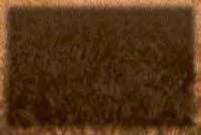



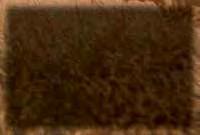
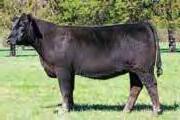
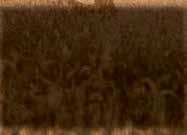

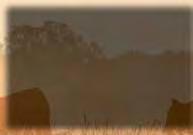
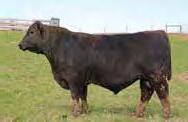


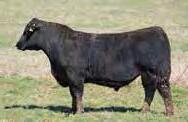
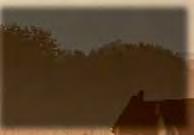
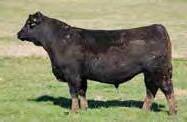
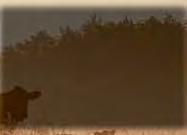








Elite Genetics tjbgelbvieh.com 04.08.23 TJB/3T KY Bull & Female Sale Mid-Kentucky Livestock Market at 1:00 ET 25 ET Bulls from the Elite TJB Gelbvieh Donors 25 Registered Females from TJB Gelbvieh 25 Commercial Bred Heifers from 3T Gelbvieh 10 Commercial Cow Calf Pairs from Grayson Springs Cattle Co. Mid-Kentucky Livestock Market 13579 S Dixie Hwy. Upton, KY 42784 Todd J. Bickett DVM (423) 667-3799 Jason Taylor (270) 352-7093 Weston Boone (270) 308-5797 TJB Annual Online Embryo Sale // 04.16.23 Selling 75 Embryos from TJB’s Elite Donors! Mark your Calendars! LOT 2 TJB K052 Request & view catalog & view videos: tjbgelbvieh.com LOT 1 TJB K062 LOT 13 TJB K112 LOT 22 TJB K222 LOT 50 TJB 6138E LOT 44 TJB 558C LOT 48 TJB 951G LOT 55 TJB 140J Sells! Sells! Sells! Sells! Sells! Sells! Sells! Sells!
250 commercials 60 registered 100 bulls
ANNUAL SALE
BV Power Play 1516 | Reg# 20303835


VAR Power Play 7018 son that


• Powerful, high performance VAR Power Play 7018 son that goes back to one of the best cows we’ve owned. 9323 maintains a calving interval of 12/369 despite being flushed numerous time; with progeny ratios of WW 12/105, YW 10/106, IMF 41/101, RE 41/103.
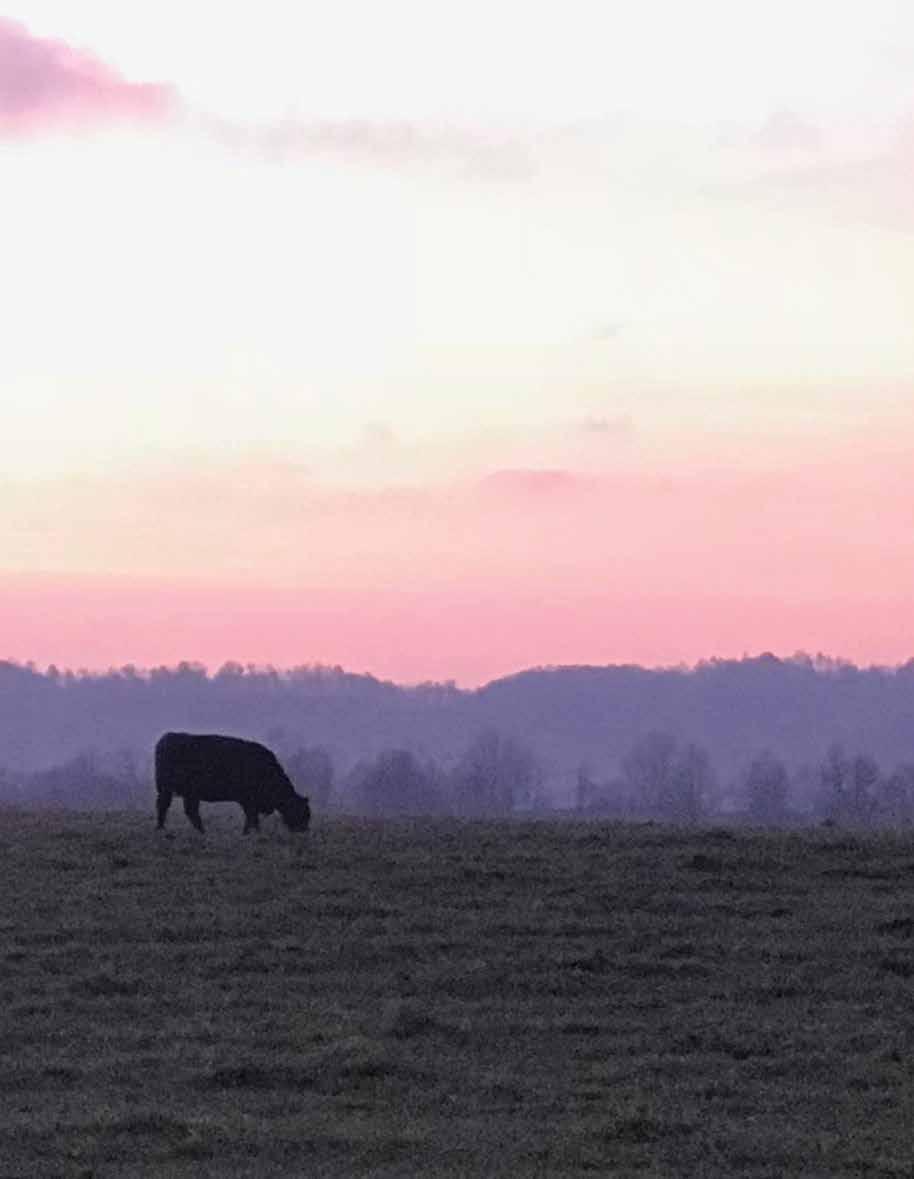
• 1516 posted impressive ratios of WW 126, YW 118, ADG 108 to arrive at top 1% WW, 3% YW EPDs. Index values of top 3% $W, 20% $B, $C.
CEDBWWWYW$W$C
BV Growth Fund 2002 | Reg# 20451664
• Stout Deer Valley Growth Fund son with a top notch set of figures. Top 1% WW, YW, 2% $W, 5% $F, 10% $C, 15% $M.
• Dam shows some of the highest progeny ratios in our herd with WW 3/118, YW 2/118, IMF 2/112, RE 2/119.
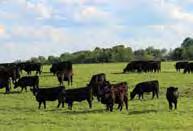
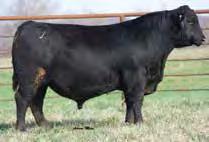

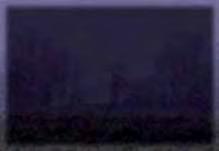

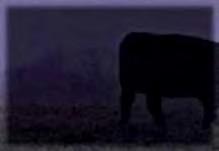
CEDBWWWYW$W$C
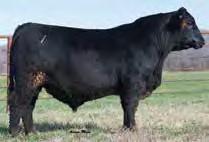
branchviewangus.com 859-533-1301 • 606-706-0355 • 859-619-0342 james@branchviewangus.com James S. Coffey Danny Smith Donald Coffey John Ethington Tim Dietrich Add pounds and dollars to your calf crop! Largest Angus Sale in Kentucky • Powerful, high performance VAR Power Play son that shows top 1% $F, 5% $B, 10 $C with top 4% WW, YW. • 1564 will add pay weight to any calf crop. BV Power Play 1564 | Reg# 20303851 • High growth VAR Power Play 7018 son that excels to top 1% WW and 2% YW. • Top notch set of $ indices with top 1% $F, 3% $W, $B, $C. BV Power Play 1546 | Reg#
CEDBWWWYW$F$C EPD +1+3.3+90+158+121+286 % Rank 22315 CEDBWWWYW$W$C EPD +6+2.1+93+159+82+321 % Rank 1233
20303850
EPD +6+3.7+93+161+83+274 %
Rank 12320
EPD +4+4.3+97+170+84+291 %
Rank 11210
APRIL
8 | NOON | HUSTONVILLE, KY
Sale book available now: branchviewangus.com
310 Females sell







































































































































 Jordan Strickler Agricultural Communications Specialist
Jordan Strickler Agricultural Communications Specialist


































































































































































 Dr. Patricia Harrelson Associate Professor of Animal Science at Morehead State University
Dr. Patricia Harrelson Associate Professor of Animal Science at Morehead State University


































































































































































